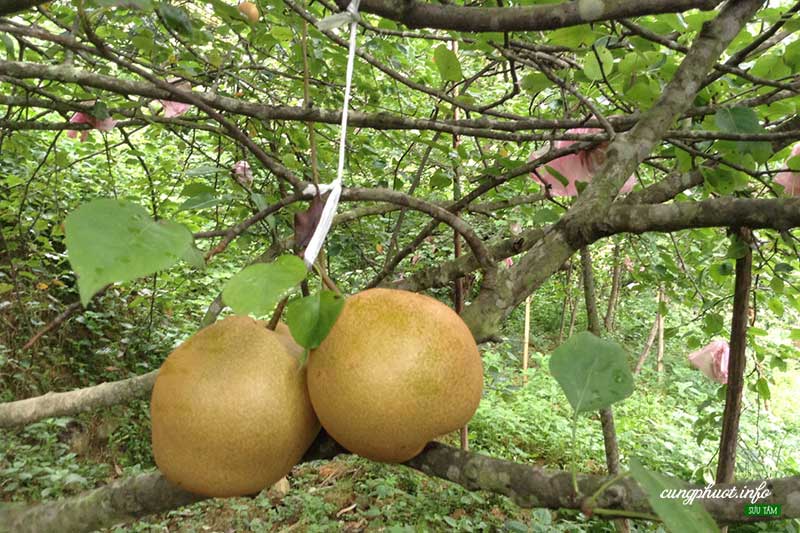
Cao Bang is a mountainous province, the border is located in the Northeast, the North and Northeast border Guangxi (China), the border is over 333 km long, the West borders the two provinces of Ha Giang and Tuyen Quang. The South borders two provinces of Bac Kan and Lang Son. From North to South direction 80 km (from Duc Hanh commune, Bao Lam district to Quang Trong commune, Thach An district). From East to West, 170 km (from Ly Quoc commune, Ha Lang district to Thach Lam commune, Bao Lam district).
Cao Bang owns many valuable historical and cultural relics such as the Pac Bo Special National Monument, the Special National Relic of Tran Hung Dao Forest, and Dong Khe Border Campaign Relic Area. Nature endowed Cao Bang with many beautiful landscapes and landscapes such as Ban Gioc waterfall, Nguom Ngao cave, Thang Hen lake; Special-use ecological forest Phja Oac-Phja Den … With diversity,
1. Which time is the appropriate time to travel to Cao Bang?
In each season, Cao Bang brings its own beauty. However, according to Cao Bang tourism experience , the best time to travel to Cao Bang is August – September when Ban Gioc waterfall is full of clear blue water. November-December is the time when triangular flowers and wild anemones bloom throughout the mountains and forests. For those who like weather that is neither too cold nor hot, in March-April, it is an apricot tree, the plum is very interesting to watch and enjoy.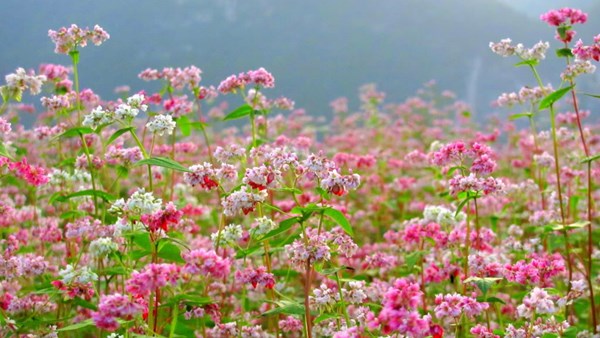
Cao Bang is amazingly beautiful during the triangle circuit season (Image: ST)
2. How to get to Cao Bang?
Cao Bang City About 280km from Hanoi, you can choose to travel to Cao Bang by bus. Every day there are about 3 bus trips running the My Dinh – Cao Bang route and all 3 routes run at night.
Ticket price is about 190,000-200,000 VND / person / ticket (depending on the garage).
When you arrive at Cao Bang bus station, you take the bus from Cao Bang bus station to Ban Gioc. Cao Bang City is about 65km from Chongqing and about 25km more from Chongqing town to Ban Gioc waterfall.
* Some cars run on Hanoi – Cao Bang route
– Hai Van car:
In Hanoi: (04) 3722.3588 – 01677.24.24.24;
In Cao Bang: 01686.24.24.24.
– Hung Thanh car:
In Hanoi: My Dinh bus station: 0972,222,694; Luong Yen bus station: 0972,222,694;
In Cao Bang: 0989.481.481.
– Khanh Toan bus: 0915.660.062 – 0913.010.062.
– Ngoc Ha bus: 0912.577.004 – 0912.455.915.
– Luong Sung Vehicle: 0912.455.915 – 0912.577.044.
You also absolutely can choose motorbike mode of transport, sometimes with its own fun when you can explore the beautiful scenery along the way.
3. Where in Cao Bang?
Cao Bang tourism is very convenient for tourists because most hotels are cheap and quite plentiful here, According to Cao Bang tourism experience , you can refer to the following addresses:
- Sunny Hotel
Standard: 3 stars
Address: No. 040 Kim Dong Street – Cao Bang City.
Sunny Hotel is one of Cao Bang hotels most chosen by tourists. The hotel is located on Kim Dong Street, in the center of Cao Bang city 150m from the Bang Giang river and Bang Giang bridge to the north, staying here is convenient for sightseeing, walking, sightseeing, shopping. and entertainment.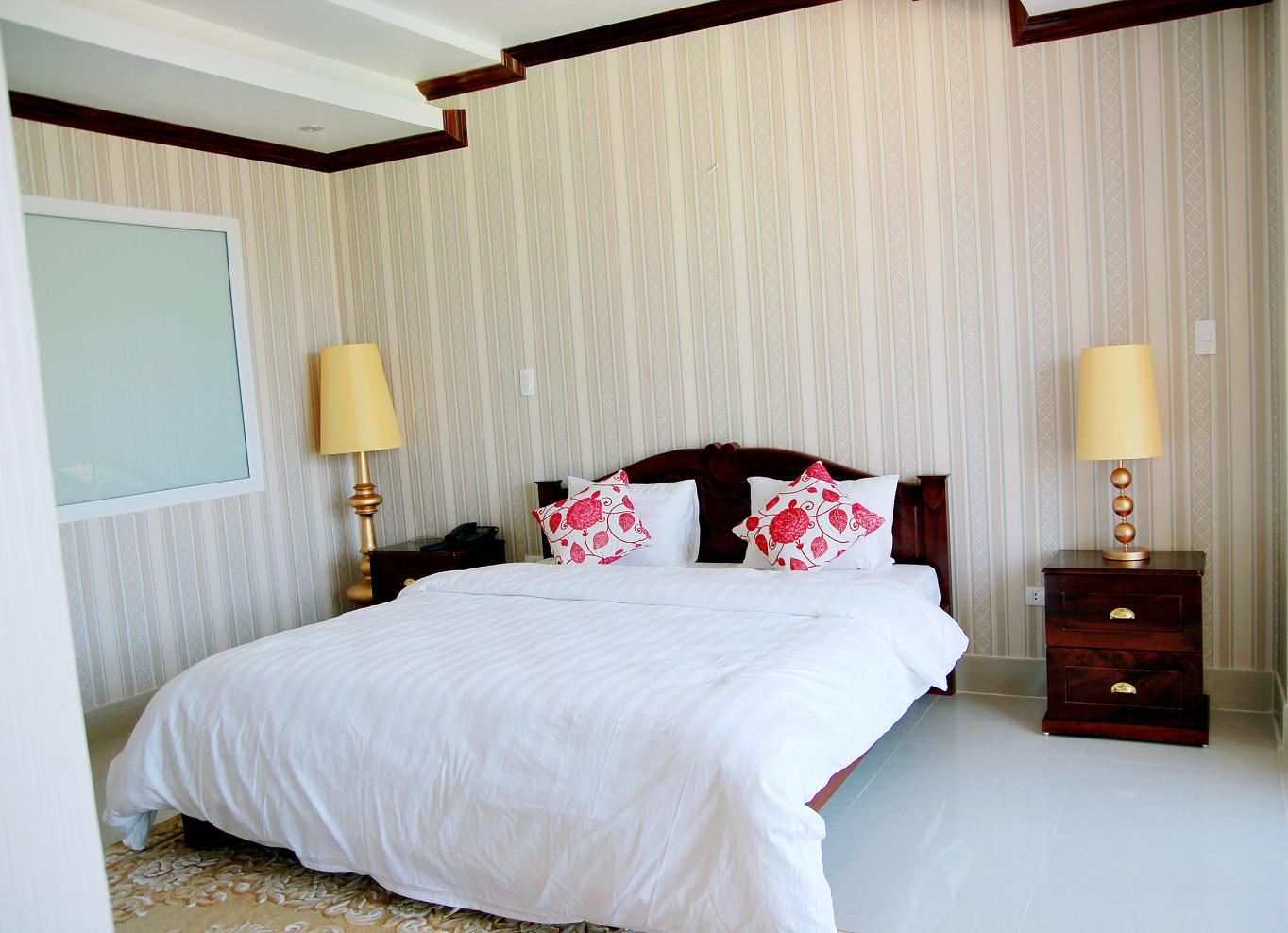
The VIP room at Sunny Hotel (Photo: ST)
- Jeanne Hotel
Standard: 2 stars
Address: 99 Kim Dong, Hop Giang, Cao Bang City.
With a geographical location, Jeanne Hotel is located in a convenient location to travel and visit famous landmarks of Cao Bang . Located in the center of Cao Bang city, Jeanne Hotel will make guests satisfied by the cleanliness, airy and services such as car rental, massage, gift shop, …
- A Dong Cao Bang Hotel
Standard: 2 stars
Address: Group 6, Ngoc Xuan Ward, Cao Bang City.
A Dong Hotel has a convenient location for domestic and foreign tourists to explore Cao Bang because it is located in the middle of the main road to the scenic spots of Cao Bang such as Ban Gioc Waterfall, Nguom Ngao Cave, Thang Hen Lake. Pac Po Cave, Tran Hung Dao Forest … Especially A Dong Hotel is located in a very convenient location for visitors who want to go to Heaven Gate, a famous spiritual place.
4. Famous tourist destinations in Cao Bang
- Ban Gioc Waterfall (About 90km from Cao Bang city)
Dubbed the fourth largest waterfall in the world among the beautiful waterfalls located on the border between countries, this is also one of the most beautiful waterfalls in Vietnam and is the most famous tourist attraction of Cao. Equal. A place that you cannot help but visit when traveling to Cao Bang .
Ban Gioc Waterfall (Photo: ST)
- Ngom Ngao Cave (3km from Ban Gioc waterfall)
Only 3km from Ban Gioc waterfall, Cao Bang tourism experience of Vntrip.vn will reveal that you should once experience exploring Nguom Ngao cave. Especially, for those who love to imagine, the cave will be an attractive destination. Because the cave is formed from old stalactites with many special and different shapes, creating a unique whole that only Nguom Ngao cave has.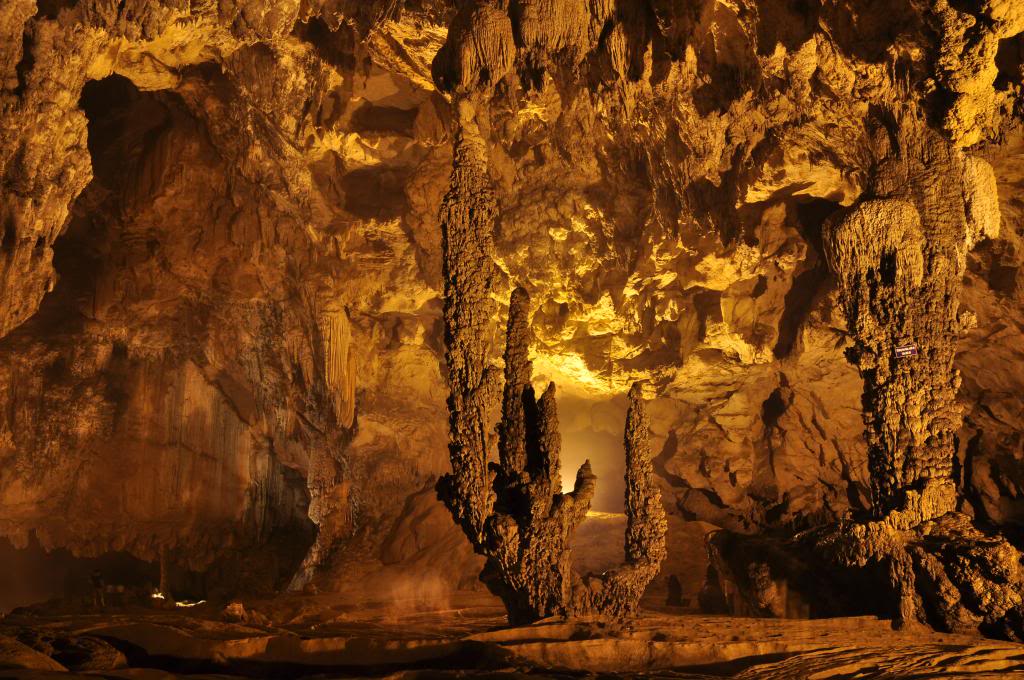
Ngom Ngao Cave will make your imagination soar … very high … (Photo: ST)
- Stream Le -n print, hang P á c Bouquets (about 55km from Cao Bang City)
Suoi Le-nin and Pac Bo cave are famous historical sites, where Uncle Ho chose to be the workplace and directly led the Vietnamese revolution after more than 30 years of traveling abroad. Suoi Le – Nin and Pac Bo cave are two places that have been very familiar to every Vietnamese from the time they were in school.
This place is also a beautiful landscape with lush green mountains, cool streams, charming mountains. Located in the middle of the old forest, the relic has a cool, windy atmosphere, always fragrant with forest flowers.
Lenin Stream is always an attraction for “flashes” (Photo: ST)
- Thang Hen Lake
Thang Hen is the largest freshwater lake among the 36 freshwater lakes in Tra Linh district. Although separated separately, they are connected by underground caves. To see the beautiful scenery of Thang Hen, you should not sleep. When the sun has just emerged from the mountains is the best time to be able to immerse yourself in the fairy landscape here. At this time, the surface of the lake looks like a jade mirror covered with a white chiffon scarf. Looming around are hidden mountains. The early scenery here is strangely peaceful, separate from the bustling city outside.
Thang Hen Lake area has a steep rocky cliff. On it, the visitors can easily recognize the grinding wood trees that have hundreds of years old, many varieties of forest orchids. This is the habitat of wild animals such as yellow monkeys, grouse, crows …
Scenery at Thang Hen Lake (Photo: ST)
5. Cao Bang Specialties
- Ant eggs cake
Referring to Cao Bang specialty is to mention ant egg tarts. Every April and May every year, people of the Tay ethnic group in Cao Bang province go to the forest to find black ant eggs to make ant eggs. Egg cake ant (in Tay called pepng rày) is made from glutinous flour, ant eggs and young leaves of fig tree. Black ant eggs in Cao Bang forest are very fertile, fat and high in protein.
Ant’s egg cake (Photo: ST)
- Donated vegetables
Hyacinth, also known as Bo Khai, Tay – Nung called Phjac Dien, often grows wild in the rocky mountains. This type of tree is very brittle and brittle. Dedicated to Cao Bang is a specialty vegetable . During spring and summer, in the towns as well as in other places, there is almost no party where there is no dish of fried greens fried with beef, pork, and chicken heart.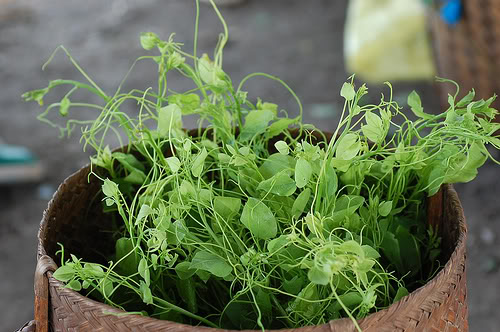
Dedicating vegetables – Cao Bang specialties as gifts from many tourists (Photo: ST)
- Khao cake
If Thai Binh is known for its banh beo, Thanh Hoa is famous for green tea, when it comes to Cao Bang’s specialty , we can’t help but mention the rice cake. With the ingredients for making cakes from glutinous rice flour combined with fatty meat, peanuts or roasted sesame to go through many final stages, the rice cake is known to be a rustic dish but contains a strength. strong suction.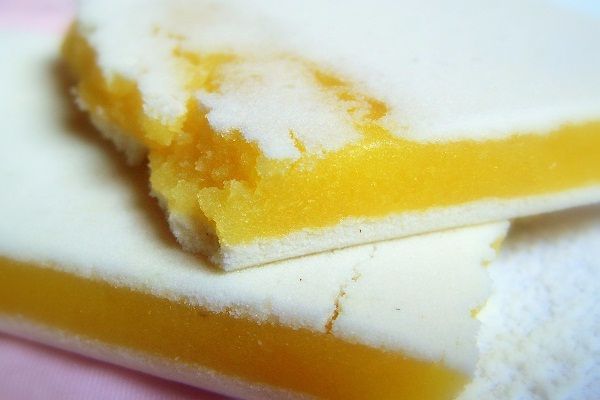
Cao Bang rice cake (Photo: ST)
- Sticky rice with Cao Bang
You can only find delicious canola fruit in the northern mountainous regions of our country. Therefore, when traveling to Cao Bang , the dishes that need to be tried are those made from fillet, of which the most delicious is sticky rice. When the weather comes to fall, people of the Tay and Nung ethnic groups in the Northeast go to the forest to pick canariums. In the autumn, in the villages of the people, there will be the opportunity to enjoy the sticky rice dish (nua marap now).
Cao Bang sticky rice (Photo: ST)
- Dumplings
This dish is very loved by many Cao Bang people, and is very memorable when going away because of its simplicity but deliciousness which is difficult to describe. Just a jar of flour, simple seasoning, with a pan full of hot oil, take the mold to measure each powder, dip into a pan of boiling oil, eat hot with some additives, herbs.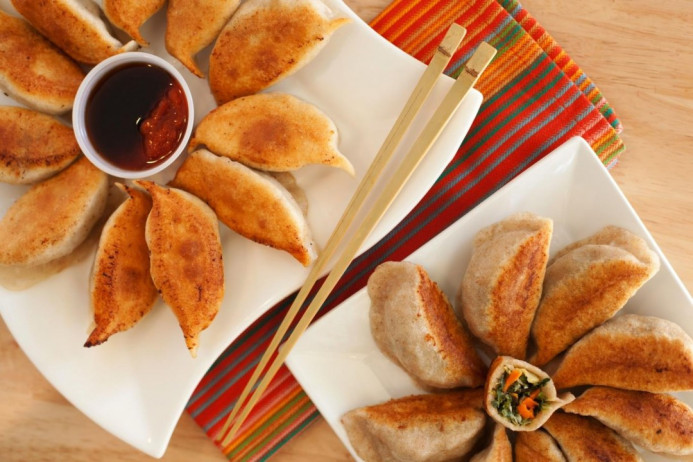
Cao Bang Dumplings (Photo: ST)
Hopefully, the Cao Bang travel experience guide has provided full information from A to Z for your journey to experience the beautiful land of the northern mountains. Traveling to Cao Bang will certainly not disappoint visitors.
From the first period of the nation’s construction, the Cao Bang region had been inhabited by the ancient Vietnamese, as evidenced by the archaeological sites, the relics were excavated in Hong Viet, (Hoa An), Can Yen (Thong Nong). Lung O (Quang Uyen) … and the legend of Pu Luong – Jia Cai, and a jangling crane. The place Cao Bang was recorded in the history books very early. The book “Du geography” compiled by Nguyen Trai in 1435 recorded “Cao Bang in the past was a foreign land of the Vu Dinh ministry; The Northeast borders Mesopotamia; The South West borders Thai Nguyen and Lang Son. There are 1 highway, 4 continents, 273 villages. That is where the fourth Rooster goes to the North “.
Cao Bang province together with Lang Son province in the Ly-Tran dynasty was called Chau Quang Nguyen. This land (Lang Son and Cao Bang) officially depended on An Nam in 1039, the Ly Thai Tong dynasty, after the country defeated Nung Tri Cao. After the fall of Thang Long in 1592 the Mac dynasty ran to Cao Bang and built this land against the Le Trinh dynasty until 1677 that it ended.
From 1886-1945, the names, boundaries and number of administrative units in Cao Bang province always changed. At the end of the nineteenth century, Cao Bang province consisted of Trung Khanh (with 3 continents: Thuong Lang, Ha Lang, Quang Uyen) and Hoa An (with 3 continents: Thach Lam, Thach An, Nguyen Binh).
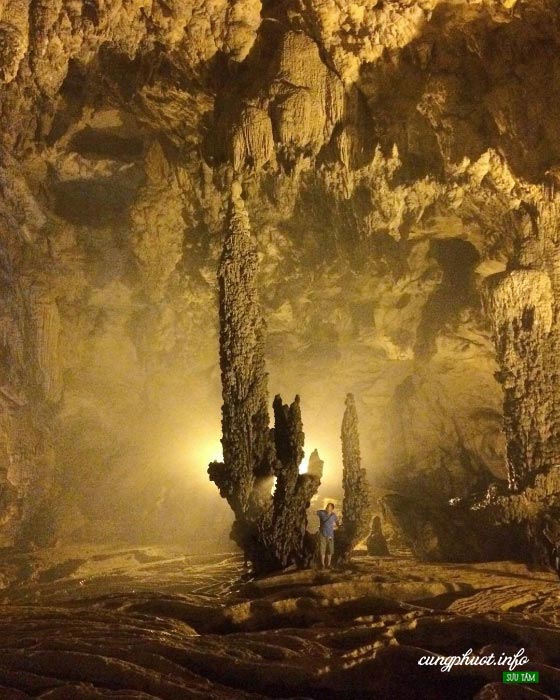 |
| Ngom Ngao Cave, a beautiful landscape located near Ban Gioc Waterfall (Photo – theevapeterson) |
On July 1, 1956, Cao Bang and the provinces of Bac Kan, Lang Son, Thai Nguyen, Tuyen Quang and Ha Giang formed the Viet Bac Autonomous Region. On March 20, 1958, Tran Bien district was renamed to Tra Linh district. On April 7, 1966, Ha Quang district was divided into two districts: Ha Quang and Thong Nong. On 8/3/1967, Quang Uyen and Phuc Hoa districts were merged into Quang Hoa district. On December 27, 1975, the second National Assembly of the Democratic Republic of Vietnam (Session V) decided to remove the zone level in the system of administrative units. It was decided that Cao Bang and Lang Son provinces merged into one province, Cao Lang, the capital of which is located in Cao Bang town.
Thus, despite many changes in the name and administrative boundary adjustments, Cao Bang’s territory is basically still stable. Currently, Cao Bang has 13 administrative units at district level (01 city and 12 districts); 199 communes, wards and townships (14 towns, 4 wards, 181 communes); There are 46 border towns and towns, 2 national border gates and 1 international border gate.
When should I travel to Cao Bang?
 |
| In winter, there are places in Cao Bang where the temperature drops below 0 degrees C, so it can snow (Photo – trungthanh1288) |
- The climate of Cao Bang is divided into 2 distinct seasons: the rainy season, lasts from April to September and the dry season lasts from October to March next year. If you intend to travel to Ban Gioc waterfall, you should go around August to September, at this time, the waterfall will be very beautiful.
- If you like to go to Cao Bang to see flowers, you can go around the end of the year around November, this is the Triangular Flower season (equivalent to the Triangular Circuit flower season in Ha Giang)
- If you like to watch the snow and snow, you should go in winter (late last year to about early next year), this time in the Pia Oac forest, the temperature is low, so this phenomenon is likely to happen. Combining with the schedule from Cao Bang to Lang Son (along That Khe Street) you can combine Mau Son tourism, where almost every winter has ice or snow.
Guide to Cao Bang
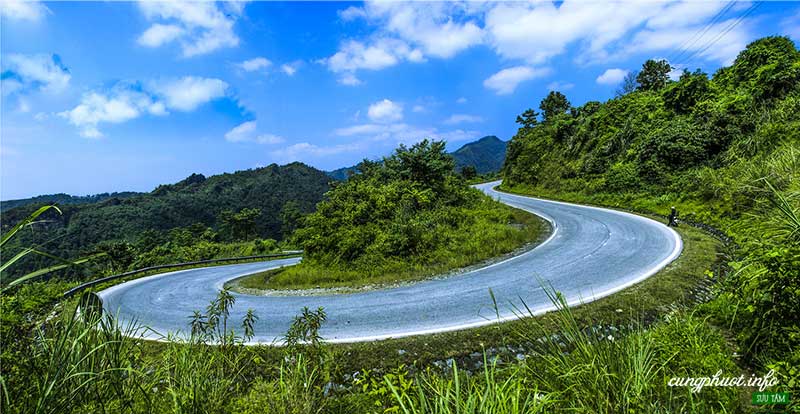 |
| Wind Pass on Highway 3, the road to Bac Kan – Cao Bang (Photo – huugiang1987) |
Cao Bang has a relatively complicated topography. The current transport system consists of only roads, including four national highways: 3, 4A, 34 and 4C including national highways 3 and 4 that have been renovated and upgraded. Up to now, the temporary traffic system satisfies the passenger transport needs.
Private vehicles
If you use a motorbike or a private car to go to Cao Bang, you can study one of the three options that Together Phieu suggests below:
- Going from Hanoi towards Highway 3 through Thai Nguyen, Bac Kan. Going this way, you can combine Thai Nguyen tourism or Bac Kan tourism , especially you can combine Ba Be Lake tourism .
- Going from Hanoi in the direction of Highway 4 to Lang Son, combining with stopping at Mau Son tourism and going in the direction of Dong Khe and That Khe to Cao Bang.
- If you go to Ha Giang by motorbike from Hanoi, when you return you can go in the direction of Dong Van to Meo Vac, go through Bao Lam, Bao Lac, Tinh Tuc (Nguyen Binh) and turn to the North of Kan. Crossed over to Ba Be Lake tourist area and then returned to Hanoi.
Public transport
If you do not want to ride a motorbike, from Hanoi you can take a bus to Cao Bang , which runs daily at My Dinh bus station and takes about 8 hours to get to Cao Bang City. Here you can rent a motorbike to continue exploring Cao Bang
Staying in Cao Bang
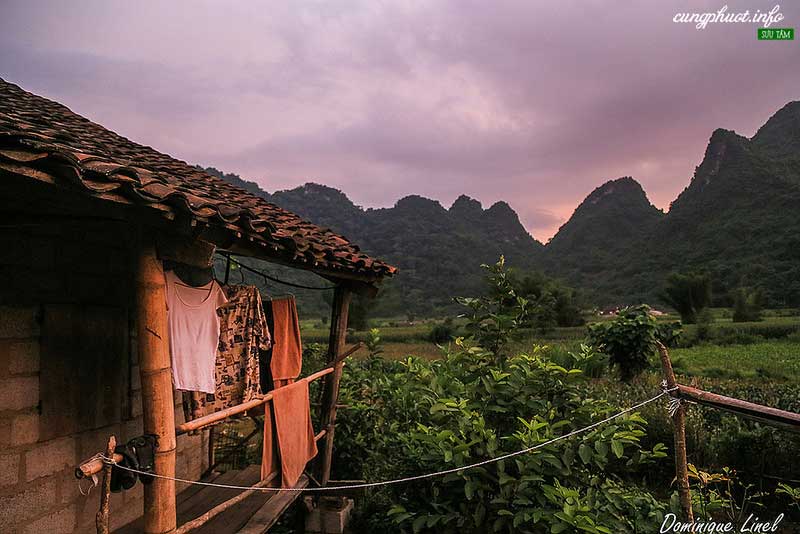
When traveling to Cao Bang, if possible, you can find homestays in the community tourism villages to learn about the culture and customs of the local people (Photo – Dominique Linel)
Hotels and motels in Cao Bang
As of March 2016, the whole province of Cao Bang has 176 tourist accommodation establishments with 2361 rooms, of which 10 are 2-star standard, 27 1-star standard. Because the number of tourists coming to Cao Bang has always increased every year, so far, basically the hotel and guest house system in Cao Bang has always been expanded and upgraded to better satisfy.
Some good hotels in Cao Bang City
HOMESTAY Primrose Homestay Cao Bang
Address: House No. 18, Hong Viet, Hop Giang Ward, Cao Bang City, Cao Bang
Phone: 098 399 48 69
View preferential rates from:
HOMESTAY Cao Bang Eco Homestay
Address: Song Bang, City. Cao Bang, Cao Bang
Phone: 0868 252 168
See preferential room rates from:
HOTEL Jeanne Hotel
Address: 99, Kim Dong, Hop Giang Ward, City of Cao Bang, Cao Bang
Phone: 091 213 01 26
View preferential rates from:
HOTEL Max Boutique Hotel
Address: 117 Orange Park, Ward Co Giang, Cao Bang
Phone: 0839781555
See preferential rates from:
HOMESTAY Luong Son Homestay Ecolodge
Address: Group 10, Hamlet Ta Lai Lang, Gia Cung, Cao Bang City, Cao Bang
Phone: 0888067899
View preferential rates from:
When traveling in Cao Bang, depending on your destination, you can choose a corresponding resting place. If you go to the Pac Bo historic site you can stay in Cao Bang city , if you go further to travel Ban Gioc Waterfall, you should move to nearby, rest in Chongqing for more convenience. for exploring this resort
Homestay in Cao Bang
Currently in some places in the province such as Cao Bang City, Quang Uyen or Ban Gioc Waterfall area there is a form of homestay to serve tourists in need. This form is still quite new in Cao Bang, but there are also many options for you.
Some good homestay in Cao Bang
HOMESTAY Primrose Homestay Cao Bang
Address: House No. 18, Hong Viet, Hop Giang Ward, Cao Bang City, Cao Bang
Phone: 098 399 48 69
View preferential rates from:
HOMESTAY Yen Nhi Homestay
Address: Ban Gioc Waterfall, Dam Thuy, Chongqing, Cao Bang
Phone: 0942 241 760
View preferential rates from:
HOMESTAY Cao Bang Eco Homestay
Address: Block 6, Song Bang Ward, Cao Bang City, Cao Bang
Phone: 0868 252 168
View preferential rates from:
HOMESTAY Khuổi Ky Homestay
Địa chỉ: Thác Bản Giốc, Đàm Thủy, Trùng Khánh, Cao Bằng
Điện thoại: 037 581 4059
Xem giá phòng ưu đãi từ:
HOMESTAY Jun’s house
Address: Group 24, De Tham, Cao Bang City, Cao Bang
Phone: 082 934 5686
View preferential rates from:
See more article: Homestay in Cao Bang (Updated 4/2021)
Tourist sites in Cao Bang
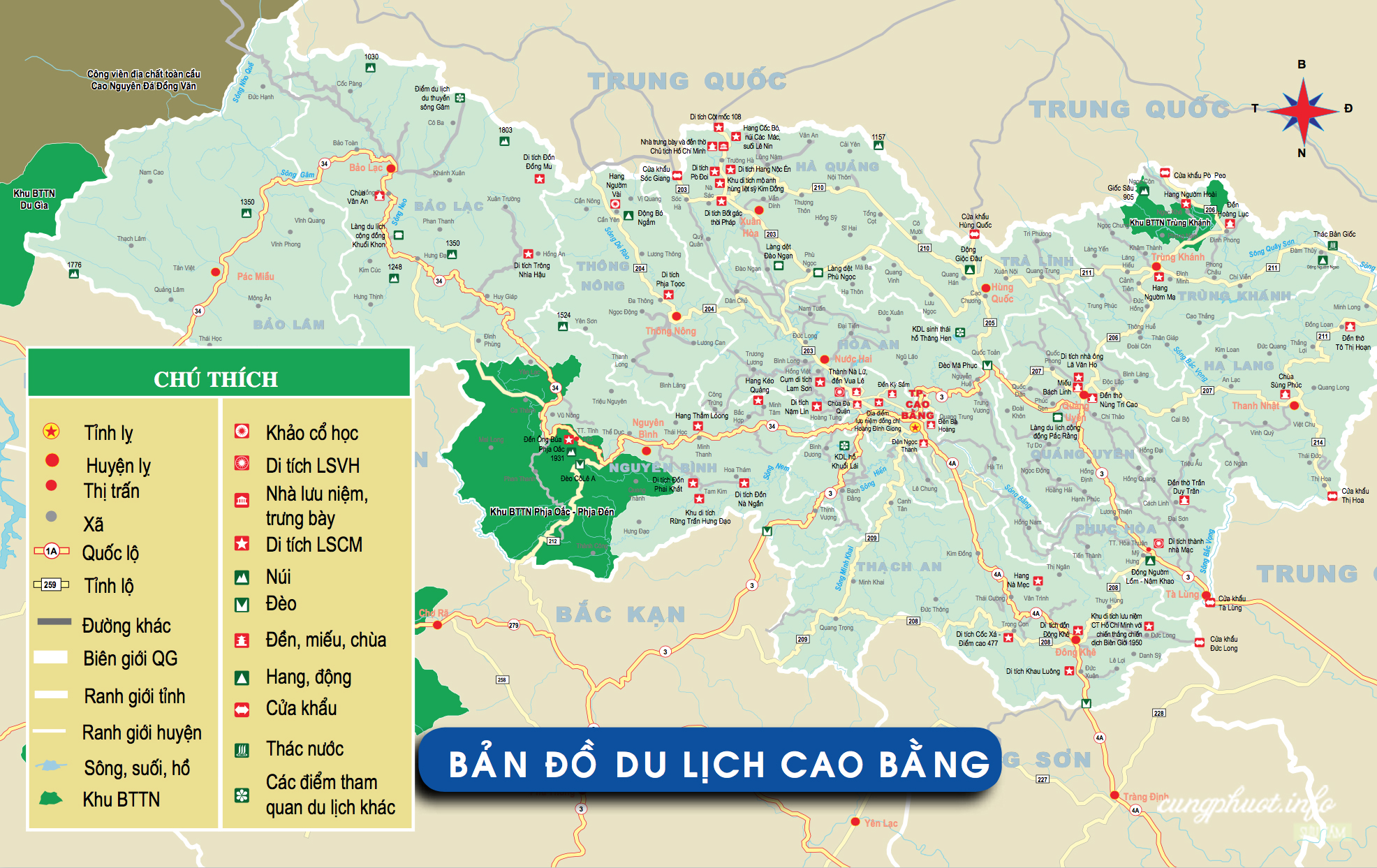
Map of Cao Bang Tourist (Photo – Travel Cao Bang)
The Creator has endowed Cao Bang with many high mountains, rivers, waterfalls, waterfalls and primeval forests, creating a majestic, poetic, wild landscape that is suitable for sightseeing and holiday tourism. rest. Cao Bang is also the cradle of the Vietnamese Revolution
Pac Bo Special National Monument
Pac Bo is located in Truong Ha commune, Ha Quang district, close to the Vietnam-China border, more than 50km from Cao Bang city. After 30 years of searching for a way to save the country and working abroad, on January 28, 1941, leader Nguyen Ai Quoc returned to the homeland through milestone 108. He chose Pac Bo as a place to live and operate. network for many years of the years 1941 – 1945. Here, leader Nguyễn Ái Quốc held political and military training classes for revolutionary cadres in Cao Bang province, translated the History of the Communist Party. Soviet into Vietnamese, drafted and published revolutionary documents: History of our country, Geography of Tonkin, Geography of Cao Bang; military training documents: Guerrilla Combat, Russian Guerrilla Experience, Chinese Guerrilla Experience …
With special historical, cultural and scientific values, the Pac Bo historic site has become one of the most important relic sites of the country to President Ho Chi Minh and the Party Central Committee. After Uncle Ho’s death in 1969, in order to pay homage to Uncle Ho’s great merits and to preserve and promote the historic value of the relic, our Party and State have paid attention to invest and embellish the Park monuments to serve visitors. In February 1971, the Pac Bo Museum was inaugurated and opened to serve visitors and research. On February 21, 1975, the Pac Bo relic was ranked as a historical revolutionary relic by the Ministry of Culture. Through the ups and downs of history, but the Monuments area has always received the attention of the Party, the Government and the people of the country. The Pac Bo relic area still maintains its activities, the conservation and promotion work has been paid more and more attention.
Le Nin Stream
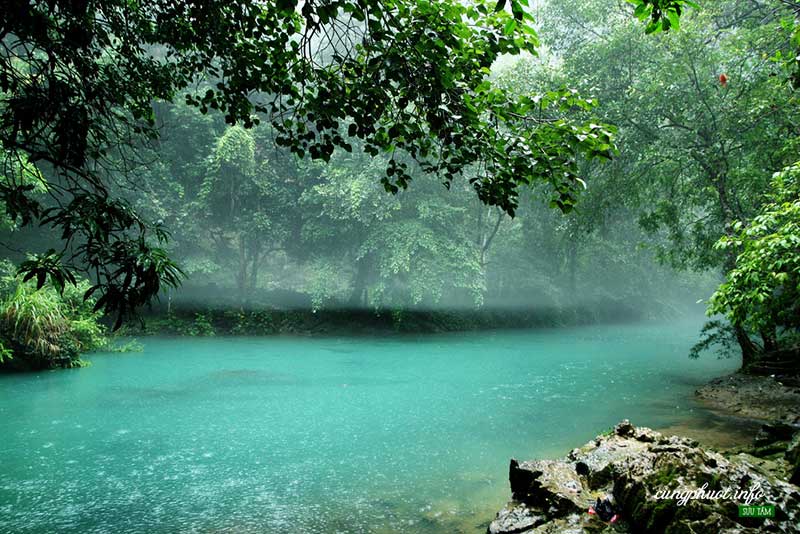
Le Nin Stream (Photo – bigbossnd)
Lenin stream is located in the historical complex of Pac Bo. With the significance of revolutionary history, Lenin Stream does not seem to attract too much attention of young people who are infatuated with the famous adventure places. However, the stream source is like a pearl with a very strange blue color, beautiful natural beauty in the middle of northeastern mountains and forests, where the headland of the country, will make people move like peace and quiet She.
Following the flow of the Lenin stream, you can visit the relics in the historical complex of Pac Bo such as: Coc Bo cave – where Uncle Ho lived and worked, Bo Bam cave, Co Ro beach , Cac Mar mountain, Nam stream, Khoi Nam shack, stone table where the ancient revolutionary discussions took place … All linked together to form a poetic water-ink picture, making people attached to each other. . Peace seems to make visitors want to live here, be satisfied with the life in the middle of nature, without any problems, peace but fun.
Coc Bo Cave
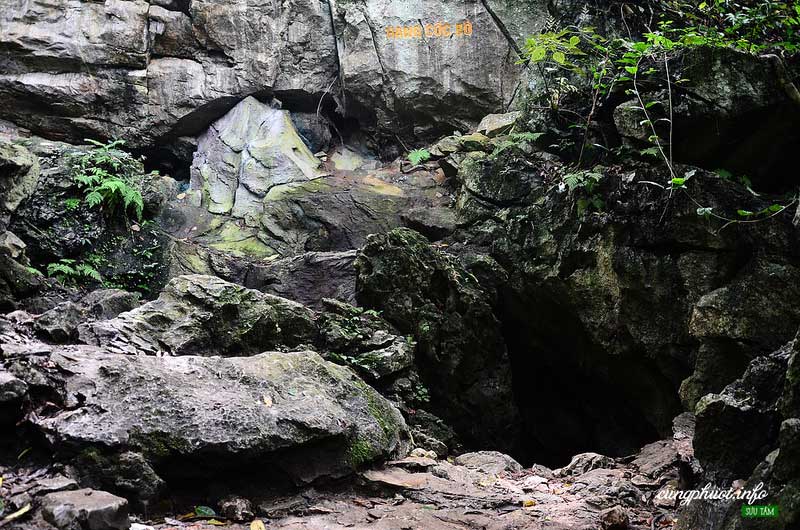
Coc Bo Cave (Photo – lengoclong8513)
Coc Bo Cave (in Nung language, Coc Bo means “watershed”) is a rocky cave located on the side of Cac Mar mountain, near where the underground water flows out from the mountain into a dangerous Le Nin stream. The cave opens to a closed road leading to the other side of the border, can safely withdraw when it is exposed … Before 1979, the cave was about 15m³ wide. Uncle Ho once recorded on the cliff the words: “February 8, 1941”, recorded the day he came to stay in this cave. In the cave was dark, humid, narrow and cold, lying deep in the ravine, at that time not many people noticed.
In the cave, there is a “bed: I lie down to rest and it is also my work place.” It was an old, chapped plank. Deep inside is the stalactite Marx statue that in the past Uncle Ho named … During the 1979 border war, the Chinese army blasted to destroy Coc Po cave. Today, Coc Po cave has been partially restored to serve tourists.
Mountain of Marks
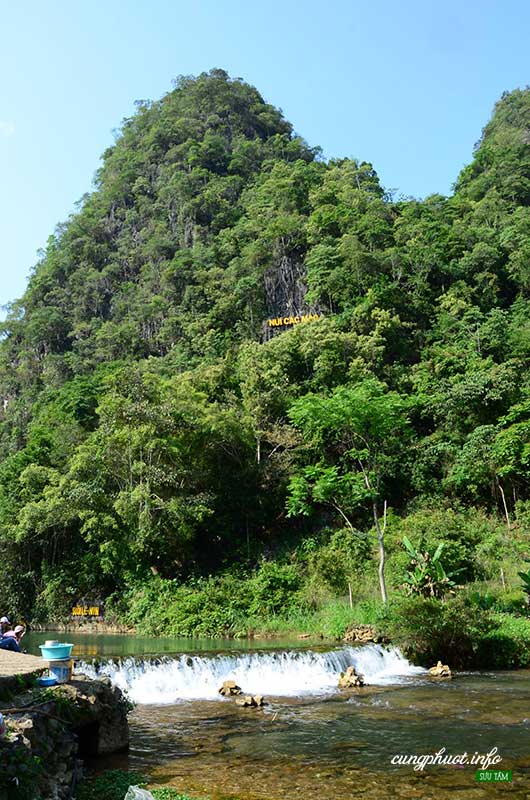
Mount Cac (Photo – Nguyen Duy Thom)
The name of the mountain in front of the cave was named after Uncle Marx’s great thinker, along with Le Nin stream, these are two thinkers who had a great influence on Uncle Ho’s career.
Milestone 108
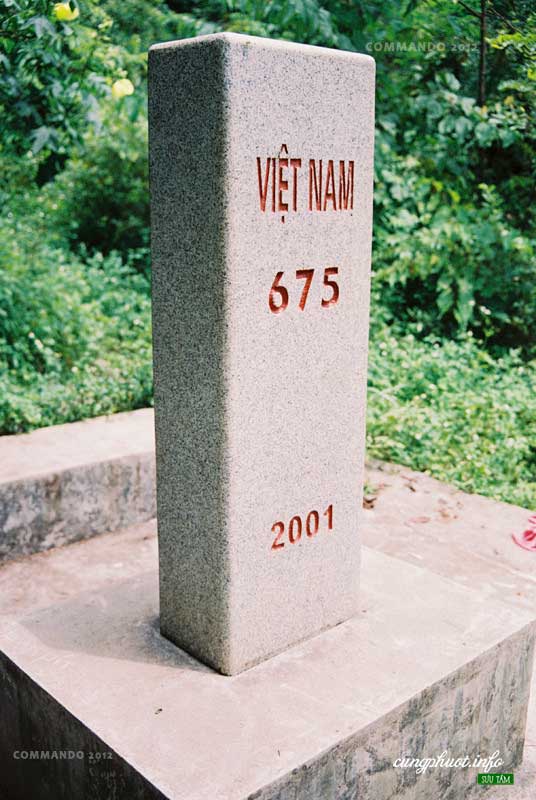
The milestone 108 before was now rebooked as 675 (Photo – Pham Trung Kien)
Now is milestone 675, is one of 314 old Vietnamese-Chinese border landmarks, made of monolithic rock, oval shape, about 70 cm high, engraved with content in Chinese and French.
Shack Khuoi Nam
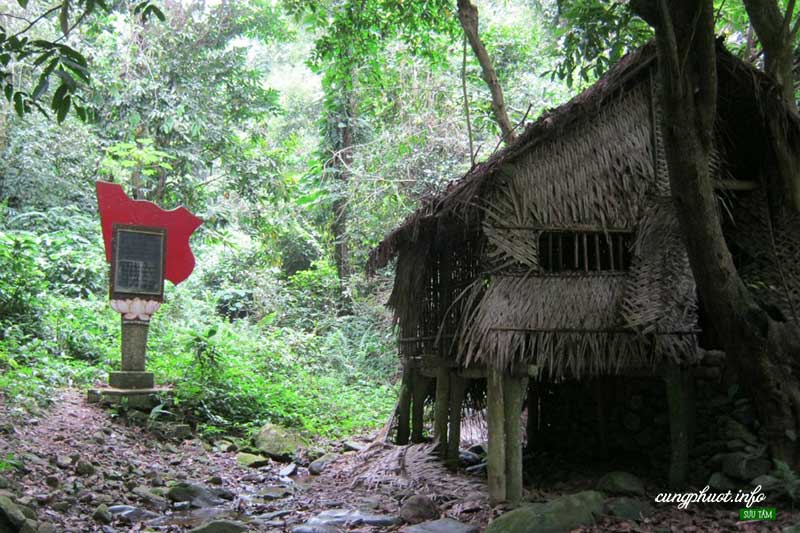
Shack Khoi Nam (Photo – Bui Chung)
Khoi Nam shack is about a kilometer from Pac Bo cave. The winding road followed the foot of the mountain, the steeper it went. It is known that the path to the old shack was just a creaky trail, now widened and paved for convenience of travel. And the ravine on the way to the shack that used to be thick is now consecutive terraced fields running back to the far forest.
This is the place where Uncle Ho stayed the longest. In addition, to ensure the safety of Uncle Ho, the cadres worked for him two more tents (Khuoi Nam II and III shelters). Khoi Nam shack has a very favorable terrain, located right at the forest gate, covered, cannot be detected from the outside, but inside it is very clear, when there is static, it can retreat, reverse Khuoi Nam line passed milestone 109 to China safely. The shack is built in the style of ethnic stilt houses, with 2 small rooms, with an area of about 12m2. The current shack was recently restored.
Mr. Ly Quoc Gun’s house
It was the house Uncle Ho lived in when he just returned to the Fatherland to direct the revolution (from January 28 to February 7, 1941). This house was built around 1937, in the style of a local stilt house.
Tran Hung Dao forest relic
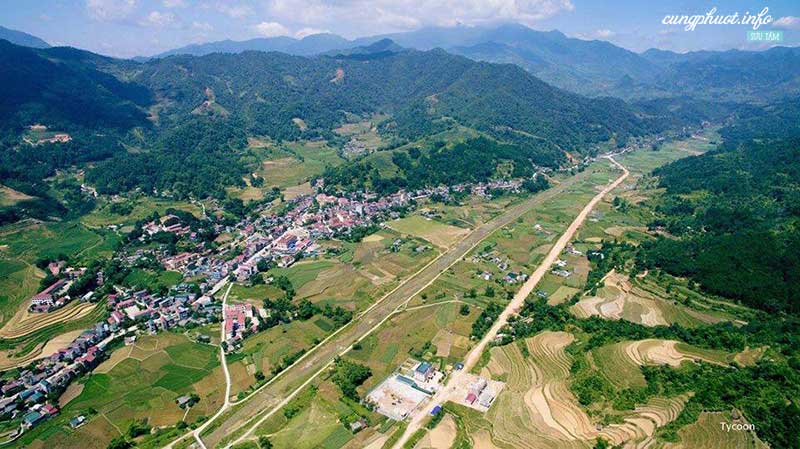
Tran Hung Dao forest is located in Nguyen Binh town (Photo – Tycoon)
Tran Hung Dao forest relic is located in Tam Kim commune, Nguyen Binh district, about 50km from the center of Cao Bang city. On December 22, 1944, under the command of General Vo Nguyen Giap, there was a ceremony to establish the Vietnam Army to propagate the Liberation of the Army – the forerunner of the Vietnam People’s Army today. A team of 34 soldiers, of which 25 are children of ethnic groups in Cao Bang province.
The relic is distributed in the area of 2 communes Tam Kim and Hoa Tham, Nguyen Binh district, Cao Bang province, including 05 points: Tran Hung Dao Forest, Tham Tham Hang, Don Phai Khat, Vam Relic, Tam Kim Commune and Don Na Ngan relic, Hoa Tham commune.
Phai Khat station relic
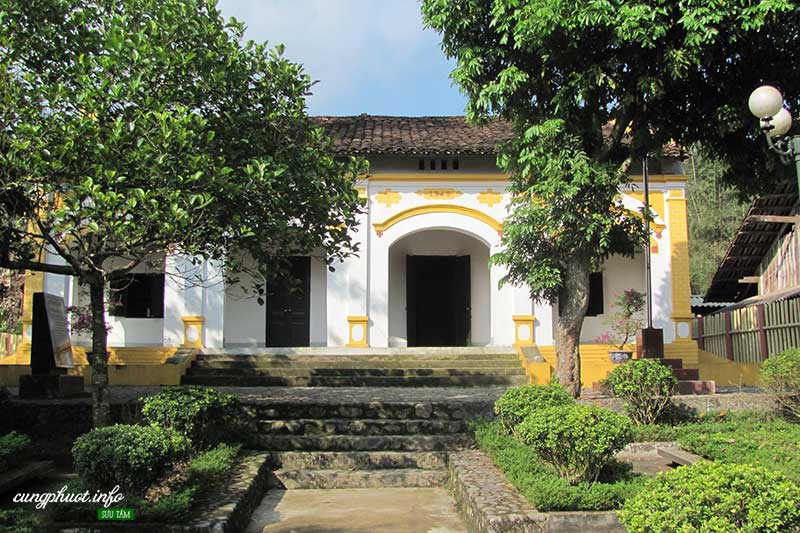
Don Phai Khat (Photo- Nguyen The Anh)
Phai Khat fortress relic was the site of the first match of the Vietnam Propaganda Army after its establishment. Don Phai Khat is located in Tam Kim commune, Nguyen Binh district, 7km from Tran Hung Dao forest. Here, at 5:00 p.m. on December 25, 1944, the Vietnam Propaganda for the Liberation Army team and the local people destroyed and captured the commanders and all soldiers, and seized the enemy’s weapons.
The grave of heroic martyrs Kim Dong
Kim Dong (real name is Nong Van Den) was born in 1929. On May 15, 1941, comrade Duc Thanh, who was a revolutionary officer, decided to set up a children’s team to save the country in Na Ma village, consisting of 4 members: Kim Dong, Cao Son, Thanh Thuy, Thuy Tien are led by Kim Dong.
At 5 am on February 15, 1943, while on duty guarding the meeting of the Viet Minh committee, when detecting that the enemy was searching near, Kim Dong quickly distracted to protect the revolutionary cadres, The enemy opened fire, Kim Dong was hit by bullets and died, when he was just 14 years old.
1950s Border campaign victory relic
The 1950 Border Campaign historic site is located in Na Lan, Duc Long commune, Thach An district, about 60 km from Cao Bang city along National Highway 4. This is a relic associated with the career. President Ho Chi Minh’s revolutionary activities, with the victory of the Border Campaign in 1950, jointly built by the High Command of the Military Region, Military Region I, Military Region II and Cao Bang Province. The relic was put into use on May 19, 2004, demonstrating the lofty ethic of “Drinking water, remember its source” for the genius leader, the beloved old father of the nation and recorded a glorious imprint. , a hero of a strategic victory in the resistance war against the French colonialists.
Nguom Puc Cave
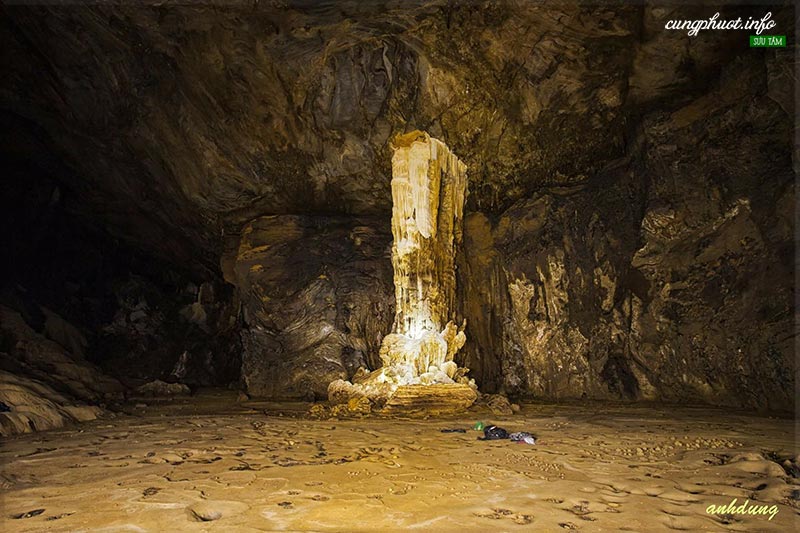
Ngom Puc is a new cave discovered, unknown to many people (Photo – anhdung)
Nguom Puc Cave is a cave located deep in a rocky mountain range bordering Le Loi commune, Thach An district (Cao Bang) and Quoc Khanh commune, Trang Dinh district (Lang Son). The cave has a depth of nearly 100 meters from the entrance, stretching with pristine stalactites and very beautiful but not many people know. The terrain in the cave is relatively dangerous, if you want to come here to explore, you have to go through narrow rock crevices, rugged mountain slopes.
Ban Gioc Waterfall
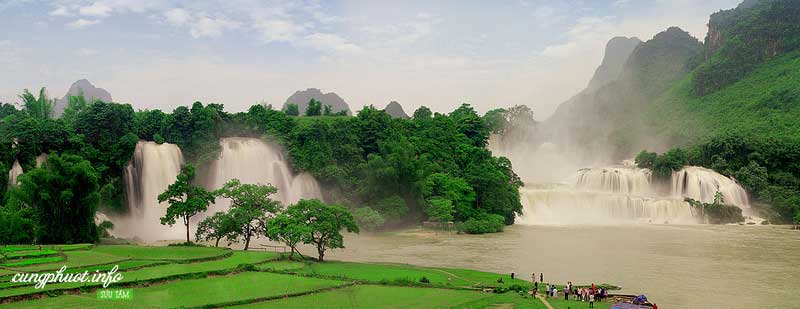
Ban Gioc Waterfall in water season (Photo – Frank Dang)
Ban Gioc Waterfall, China called Duc Thien-Ban Uoc waterfall pair (Chinese: 德 天 – 板 約; pinyin: Détiān – Bǎnyuē), is one or two waterfalls located on the Quay Son River at the border between Vietnam. and China. If viewed from the bottom of the waterfall, the left and the western half of the waterfall on the right belong to the sovereignty of Vietnam in Dam Thuy commune, Trung Khanh district, Cao Bang province; the eastern half of the right waterfall belongs to Chinese sovereignty in Duc Thien village, Thac Long town, Dai Tan district, Sung Ta city of Guangxi Choang ethnic autonomous region. This waterfall is about 20 km northeast of the district capital of Chongqing, about 208 km from the Nanning capital of Guangxi.
See also: Experience in traveling to Ban Gioc Waterfall (Updated 4/2021)
Ban Gioc waterfall is located on the flow of Quay Son River (歸 春 河, Sino-Vietnamese sound is “Quy Xuan Ha”). This river originates in China, flows towards the border of the two countries and then into the Vietnamese territory at Po Peo in Ngoc Khe commune, Trung Khanh district. From Ngoc Khe commune, the river flows through Dinh Phong and Chi Vien communes, when reaching Dam Thuy commune, the river glides around at the foot of Co Muong mountain, then through the fields of Dam Thuy, through the corn field on Gioc village, back again. the border then splits into several branches. The riverbed there suddenly fell about 35 m, forming Ban Gioc waterfall. After falling at the foot of the waterfall, the river turns completely into Chinese territory.
Ban Gioc Falls is the world’s fourth largest waterfall among waterfalls located on a border between countries (After Iguazu falls between Brazil – Argentina, Victoria Falls is located between Zambia – Zimbabwe; and Niagara Falls between Canada and the United States of America. )
Legend has it that there was a beautiful and beautiful girl who was allowed to go to the king, but she desperately escaped with the person she loved. After finding each other, they fell asleep together. The villagers witnessed the pouring rain for a week.
Water flooded streams, no one dared to go out because of heavy rain and fierce thunder. Strangely, when the rain stopped, two large waterfalls were found to be pouring white water beside the village. At the foot of the waterfall, the water surface is green and gentle, as if it is not entangled with bare dust. Since then, people have called this place Ban Gioc waterfall to commemorate a time when a woman was a king and was also the pride of the Tày people with the beauty of heaven.
Nguom Ngao Cave
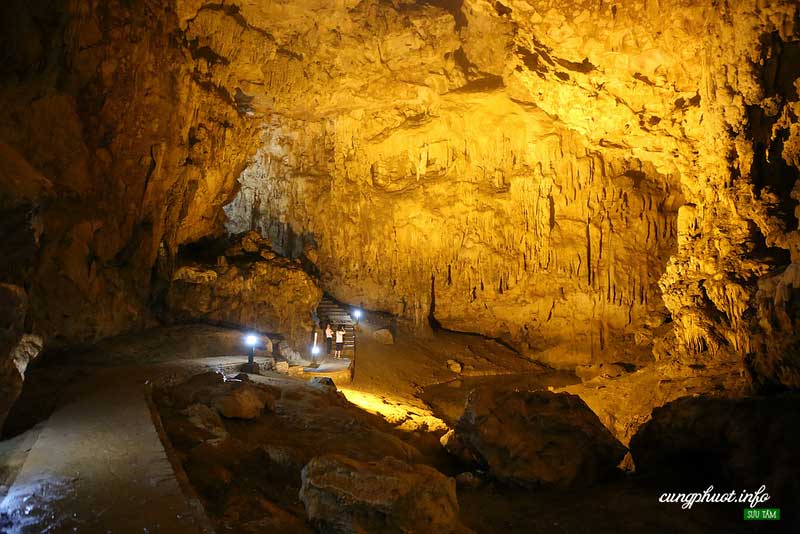
Inside Nguom Ngao Cave (Photo – Le Ngoc Long)
Nguom Ngao Cave is located in Gun village, Dam Thuy commune, Trung Khanh district, Cao Bang province. The cave has a length of 2,144m. The cave consists of three main doors: Ngom Ngao, Ngom Lom (ie wind door, cool all year round) and Ban Thuon door behind the mountain in Ban Thuon.
According to the Tay language, “ngom” is “dynamic”, “clam” is “tiger”; “Nguom Ngao” means tiger action. Nguom Ngao Cave is divided into three main areas: The Four Heavenly Pillars, the Central and the Treasure Area. Nguom Ngao has an extremely interesting beauty made up of gorgeous layers of stalactite and golden stalactite. The colorful stalactites grow from below, from above the tall arches with many beautiful shapes reflecting shimmering light.
Buddhist Temple Tich Truc Lam Ban Gioc
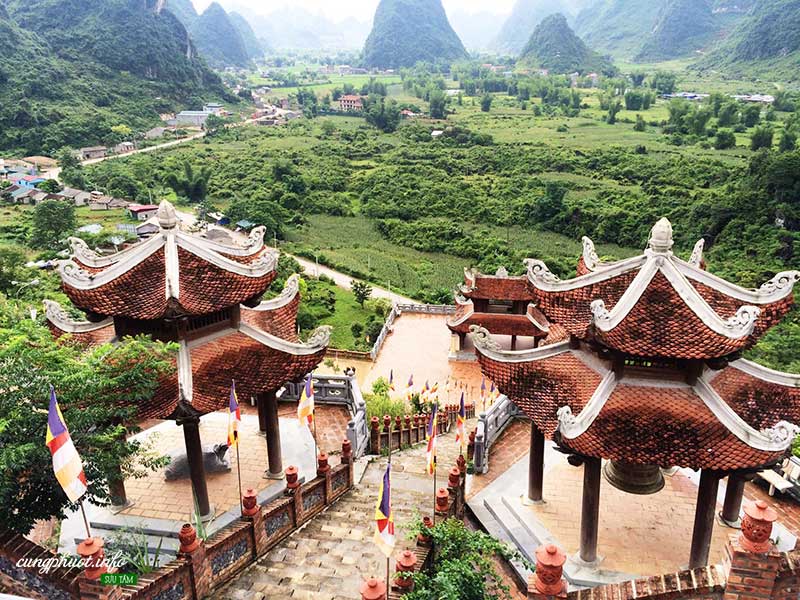
Ban Gioc waterfall in the distance as seen from Tich Truc Lam Ban Gioc Pagoda (Photo – Kieu Van)
Buddhist Temple Tich Truc Lam Ban Gioc – the first temple built in the northern border of the country was approved by the People’s Committee of Cao Bang province to build. In June 2013, the pagoda of Tich Truc Lam Ban Gioc was started at Phia Nhoc mountain, 500m from Ban Gioc waterfall. Items of Tich Truc Lam Ban Gioc Buddhist pagoda such as Tam Quan pagoda, Bodhisattva statue floor, Tam Bao, ancestor house … are built in traditional Vietnamese Buddhist architectural style.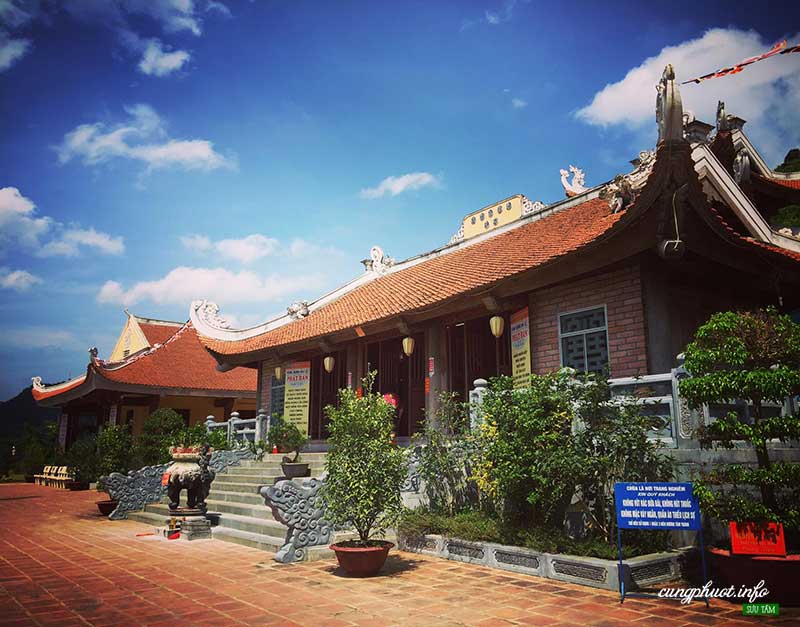
Photo – Nguyen Hoang
There is also a temple to the hero Nung Tri Cao – a figure and symbol of culture in the eleventh century in Cao Bang. The project was built on an area of 2 hectares with a budget of about 38 billion VND, mainly from the socialization source mobilized by the Central Vietnam Buddhist Church, contributed and sponsored by corporations and donors.
Phuc Sen forging village
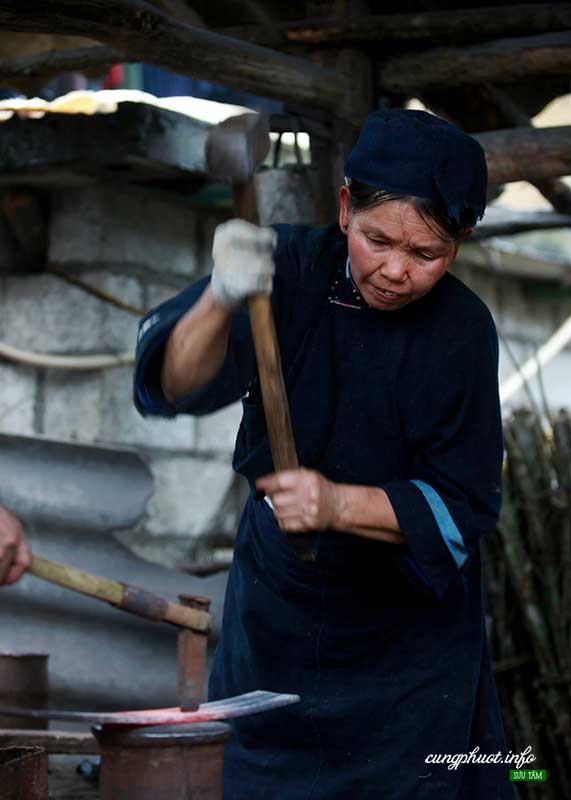
Phuc Sen forging village is quite famous in Cao Bang (Photo – Le Bich)
The Nung An people in Phuc Sen commune, Quang Uyen district, Cao Bang province have a profession of forging. Forging appeared in Phuc Sen commune a long time ago (not sure how long, but certainly over 200 years). It can be said that this is one of the most unique craft villages in Cao Bang province as well as in Vietnam. It is also because of this unique forging profession that annually the number of tourists coming to Phuc Sen commune is relatively large, bringing significant income to the people.
Pac Rang village community-based tourism
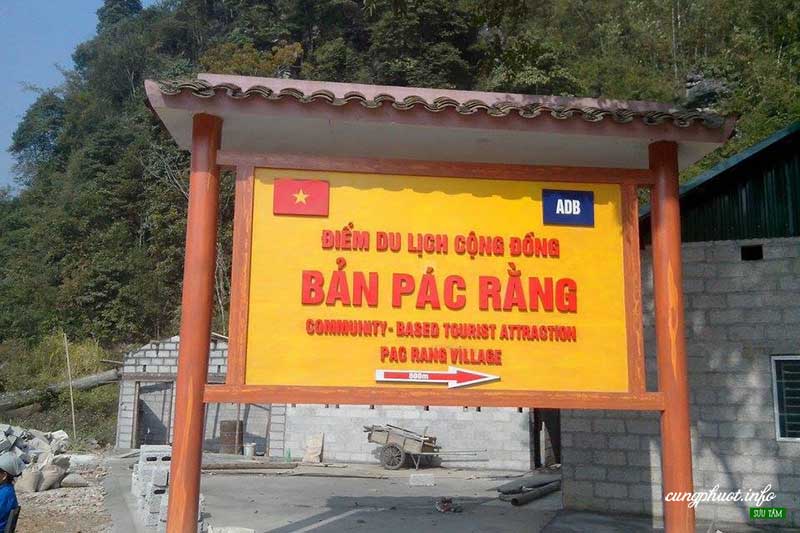
Photo – My Anh
Pac Rang village, in Phuc Sen commune, is located along Highway 3, from Cao Bang town to Ta Lung national border gate, in front of the village is a small field facing the National Highway, behind are majestic rocky mountains with The primeval forests create a peaceful, green space that any visitor can feel when coming to this area. This is the residence of 51 households of Nung An ethnic group, with more than 250 people.
Pac Rang has been selected as a destination for CBT development associated with poverty alleviation through the Greater Mekong Subregion Sustainable Tourism Development Project funded by the Asian Development Bank. Coming to Pac Rang, tourists are attracted by the traditional culture of the ethnic group that shows the boldness of labor, production and daily activities of the people here.
The most noticeable thing when coming to Pac Rang village is that households still retain the traditional wooden-stilt house architecture with 2-storey structure. The first floor is cattle barns, sanitary works, on the side is the forge. The second floor is the living space for family members, including: bedrooms, living room and kitchen. arranged scientifically and hygienic. Mezzanine is used as a storage of agricultural products.
Thang Hen Lake
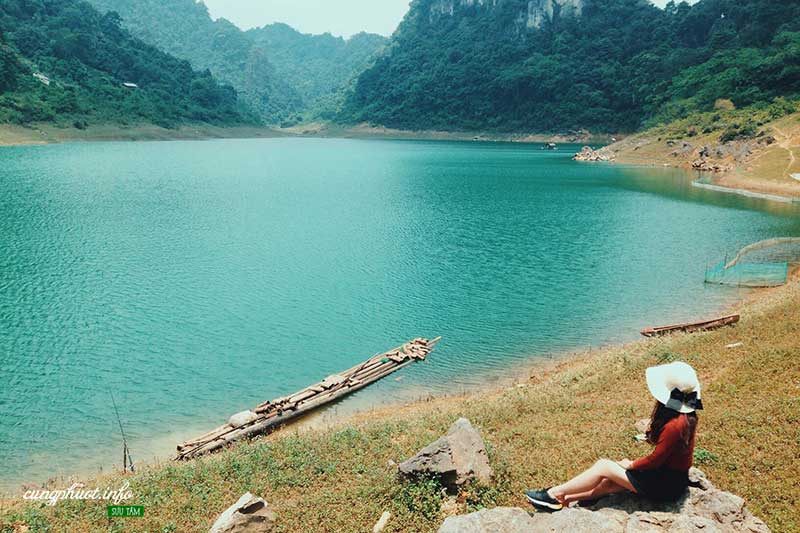
Thang Hen Lake (Photo – Nguyen Thuy Huyen)
Located in Quoc Toan commune, Tra Linh district, Cao Bang province at an altitude of thousands of meters above sea level, Thang Hen Lake is a beautiful lake among 36 large and small lakes in the mountainous areas of Tra Linh district. Located in the middle of a mountainous region and the green color of trees reaching over cliffs reflecting into the clear water, winding along the valley bedside quarries. Thang Hen Lake is diamond shaped, 100m to 300m wide, and 500m to 1,000m long. Upstream is a large cave, from the cave, water flows out day and night. It is especially interesting when the people here say that every 10 years, suddenly the water of Thang Hen Lake is almost dry and after a few days the water rises again. And even more impressive is that during the flood season, Thang Hen Lake still retains its characteristic emerald green color, while other lakes in the region turn bright red.
Thang Hen Lake has a very interesting legend. According to folk legend, in the old days in Cao Bang, there was a young and intelligent man named Sung. He passed the exam to become a mandarin and was rewarded with seven days of honor by the king. Back home, he married a beautiful Booc. Intrigued by his beautiful newlywed wife, he forgot the day he returned to the business. Until Saturday night, he suddenly remembered, said goodbye to his wife and parents and ran back to his family. In the middle of the night in the wilderness, he ran 36 steps, then fell his head and hit the mountain and died. His 36 steps today are 36 large and small lakes with different names for the dialects of Tra Linh district. Legend has it that the place where he lay down is today Thang Hen Lake.
Nam Tra Waterfall
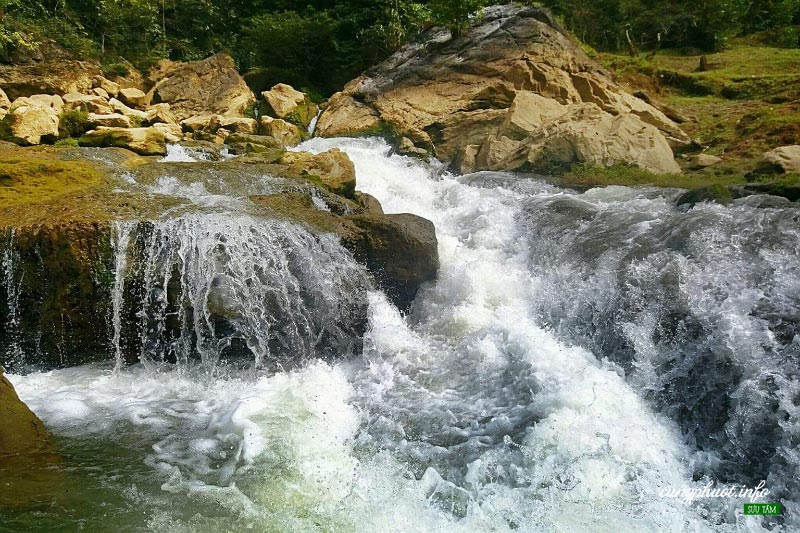
Nam Tra Waterfall (Photo – Dam Hien)
Mat Than Mountain – Nam Tra Waterfall is located in the valley of Ban Danh hamlet, Quoc Toan commune (Tra Linh), about 2 km from Thang Hen Lake, with majestic natural beauty, wild, newly discovered but collected. attracts many tourists to visit, explore …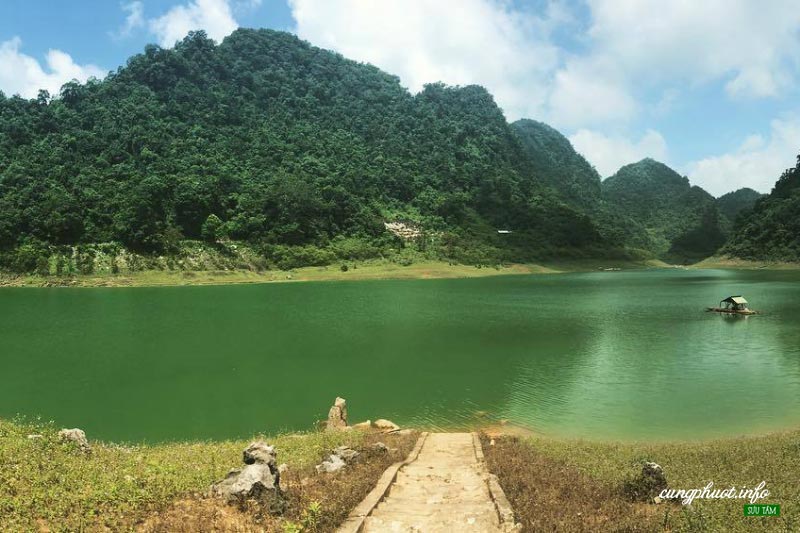
Tuyệt tình cốc Cao Bằng (Ảnh – Nhà nghỉ Vy Vy)
From the provincial road, turn right to Thang Hen lake to Ban Danh village, continue to turn to the trail at the foot of the mountain, you can only walk in, about 1.5 km to go to Mat Than mountain – Nam Tra waterfall. From the top of the mountain, visitors are overwhelmed by the view of the 15-hectare Nam Tra lake that has run out of water, a vast green grass surrounded by mountains. Under the mountains are the winding cornfields that create a charming beauty of water. This place is loved by the people who move to give the name ” Absolutely Tinh Coc Cao Bang “
Ma Phuc Pass
Ma Phuc pass is the most beautiful pass among the passes on National Highway 3 from Phu Lo to Ta Nung border gate, 22 km from Cao Bang. Located in Quoc Toan commune, Tra Linh district, is the boundary of Hoa An district and Tra Linh district.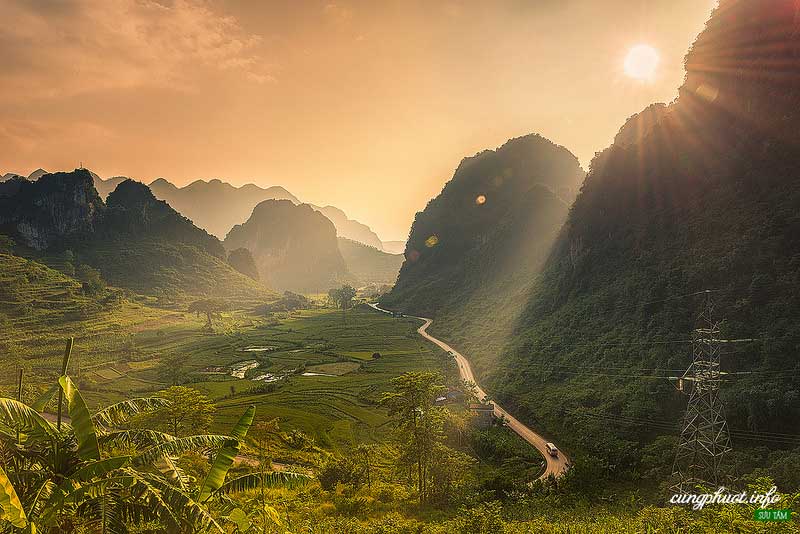
Sunset on Ma Phuc Pass (Photo – tu_geo)
Ma Phuc pass is about 620 m high (it is necessary to pass seven steep turns to reach the top). The pass is only 2 slopes in the north with a bend, and the northern slope is in the territory of Chongqing district.
There are many theories about the name Ma Phuc, but when we arrive, we can see that the two sides of the highway have two limestone blocks, standing together like two horses lying prostrate. From the foot of the pass, turn left is the village of Tong Cot, where there is a famous old banyan tree and the buffalo market on Sunday. Then you can continue to visit the ancient village of Na Short, to the border gate of Tra Linh. Or pass Quang Uyen, turn right to reach the Ta Lung international border gate. Turn left up to Chongqing, the magnificent Ban Gioc waterfall and the road to Ha Lang, the final point of Cao Bang.
Khau Lieu Pass
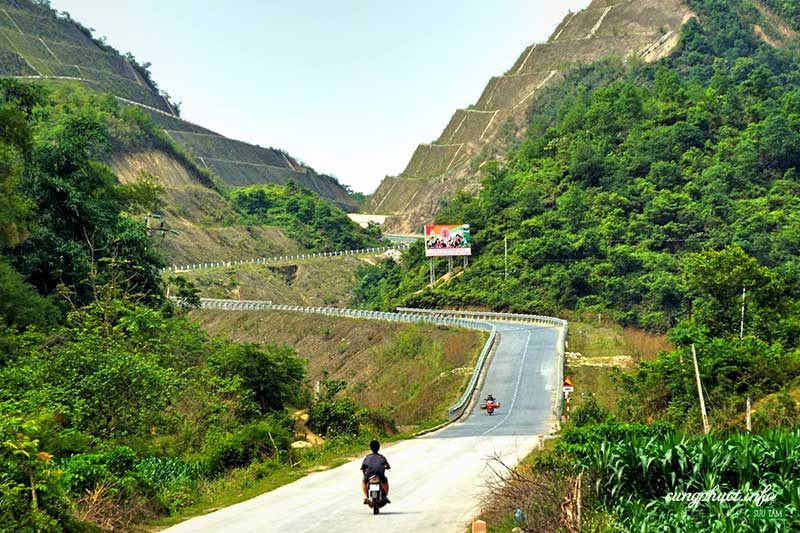
Khau Lieu Pass connects Quang Uyen and Chongqing (Photo – Cao Bang Que Toi)
Khau Lieu is called according to the Tay language, which means Lieu Pass. Standing high above and looking down, Khau Lieu pass softly runs between the mountain ranges of Cao Bang, like a dragon winding, winding, embracing the mountain. This is also the test-drive pass of many people who want to conquer difficulties before the majestic nature. Khau Lieu Pass can be said as a highlight in the beautiful mountain countryside picture of Chongqing.
Not as famous as Ma Phuc pass located earlier, Khau Lieu Pass has a poetic beauty, colorful and harmonious with the natural scenery. You will feel happy and happy when you pass the height of Khau Lieu Pass. Standing on the top of the pass, zooming in, breathing the pure air of the mountains and forests, it’s really nothing more interesting.
The border gates between Cao Bang – China
Ta Lung International Border Gate
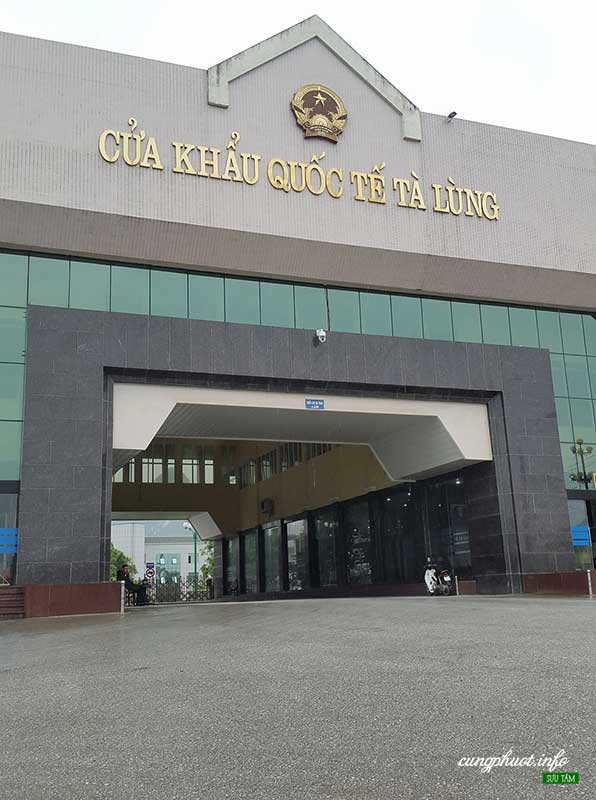
Ta Lung International Border Gate (Photo – Thieu Gia Chan Dat)
Ta Lung border gate is an international border gate in Po Tap village land, Ta Lung town, Phuc Hoa district, Cao Bang province, Vietnam. Ta Lung border gate is the end point of National Highway 3, followed by Thuy Khau bridge on Bac Vong river, communication to Thuy Khau border gate, Guangxi province, China.
Ta Lung border gate is the main gate of Cao Bang province, located near the junction where the Bac Vong River flows into the Bang River. Bac Vong River has a long stretch of natural border in the east of Phuc Hoa district.
Tra Linh border gate

Tra Linh border gate (Photo – Trai Ho Nguyen)
Tra Linh border gate or Hung Quoc border gate or Na Doong border gate is the national border gate in the land of Gia village in Hung Quoc town, Tra Linh district, Cao Bang province, Vietnam. Tra Linh border gate is traded to Long Bang border gate in Bach Sac city, Guangxi province, China.
Tra Linh border gate is the end point of Provincial Highway 205, about 6 km from Hung Quoc town to the north. The name of Na Doan border gate is called after Na Do village which is the village in front of Gia village when going to the border gate. However, the official name and is used in administrative, border and customs officials is Tra Linh border gate.
Po Peo border gate
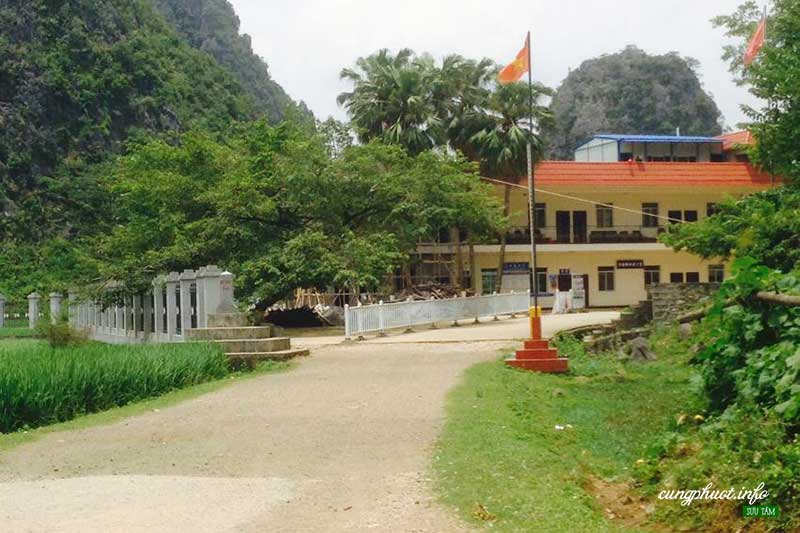
Po Peo Border Gate (Photo – Kieu Hoang)
Po Peo border gate is a border gate in Na Han village, Ngoc Con commune, Trung Khanh district, Cao Bang province, Vietnam, is traded to Nhac Vu border gate in Quang Tay province, China.
Po Peo border gate is the end point of Provincial Highway 211, about 22 km from Chongqing town along this road. The border gate in the east where the Quay Son River flows into Vietnam is about 2 km. The river section on the Chinese side is named Nan Tan He.
Ly Van border gate
Ly Van border gate is a border gate in Ly Van village, Ly Quoc commune, Ha Lang district, Cao Bang province, Vietnam, and is traded to Thac Long border gate in Dai Tan district, Sung Ta city, Quang Tay province, China. Ly Van border gate is 60 km far from Cao Bang city in a straight line to the northeast.
Soc Giang border gate
Soc Giang border gate is a border gate in the land of Soc Giang village, Soc Ha commune, Ha Quang district, Cao Bang province, Vietnam, which is traded to Binh Mang border gate in Bach Sac city, Quang Tay province, China.
Soc Giang border gate is 42 km from Cao Bang city in a straight line to the northwest, and about 55 km along the provincial highway 203. The border gate is close to where the Bang River flows into Vietnam.
Vietnam – China border landmark
Out of 1,971 landmarks located in the 7 northern border provinces, Cao Bang has the most landmarks (634 landmarks), so it is called the province with a ‘milestone strength’ – a strength that has to be exchanged for many. sweat, bones and blood. You love to check-in with border landmarks that can be referenced and combined when traveling to Cao Bang, but you should also note that excluding border landmarks in large locations (for example large border gates, tourist destinations) the rest of the border markers are quite sensitive areas, you should ask for permission if you get approval, then ask the border guard to lead it out.
Phia Black – Phia Oac
Phia Oac – Phia Den Nature Reserve, also known as Phja Oac – Phja Den, is a special-use forest with an area of 10,245.6 ha located in 5 communes of Nguyen Binh district, Cao Bang province). This resort used to be a resort discovered and built by the French in the early 20th century. Phia Oac – Phia Den region has the distribution of 125 flora families, 289 plant genera and more than 352 plant species. There are many rare and endangered species. The habitat is also recorded with 66 species of butterflies.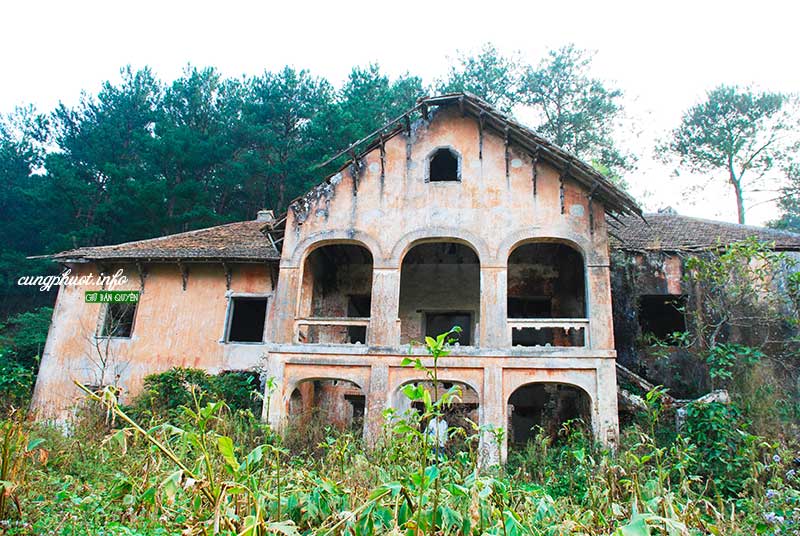
The Red House, the largest remaining villa in Phia Oac (Photo – Cungphuot.info)
According to current recorded documents, the ancient villas were built in the early nineteenth century. At this time, the French colonialists stepped up the mining of ore in Tinh Tuc and pushed thousands of workers from all over here to exploit labor, dig ore, and plunder resources.
To ensure the supervision of the large number of workers, the French sent troops here to garrison and built high-class resorts for officers and soldiers on the spot on a large scale. The abandoned old villa complex is the resort of French officers.
In the area in the middle of Phia Oac mountain, there are two main types of houses: independent villas for senior French officials and adjacent villas – areas for soldiers and small officials.
About 5km from Phia Oac special-use forest, there is a special luxurious villa called the Red House. Heard, its owner was formerly named Phangen. This is the largest and oldest villa in Phia Oac area.
Cao Bang fair market
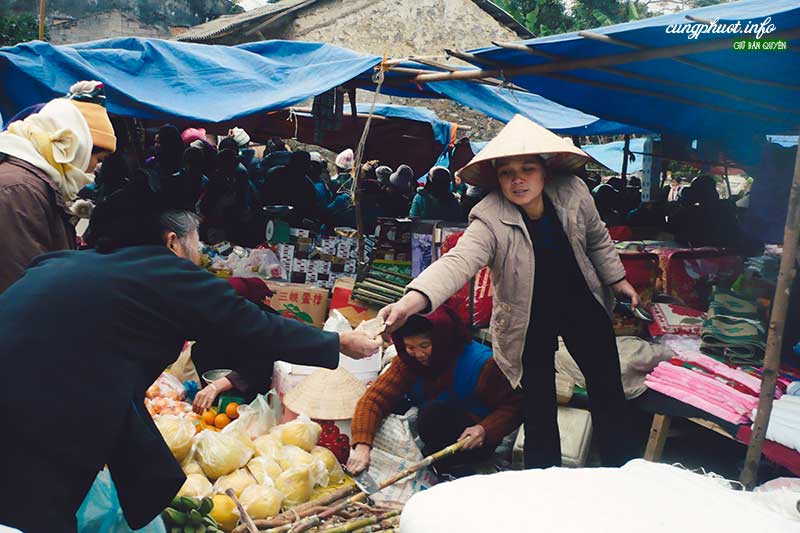
A market in Cao Bang (Photo – Cungphuot.info)
In the highlands, the villages are far apart, many villages have only a few roofs, so daily life is almost closed. Therefore, going to the market to buy and sell goods is also a place to exchange information, exchange feelings, and date couples.
Delicious food in Cao Bang
Rolled rice cake (Floating cake)

Mangrove Cao Bang (Photo – Khanh Ỉnn)
Coong is made from delicious sticky rice mixed with some non-glutinous rice. The filling is crushed roasted peanuts, which can be added with sugar and sesame seeds. The ball is usually pure white, many people mix flour with Gac or soak rice with rosemary leaves, pineapple leaves to create new colors, different flavors and aromas. Completely free of chemical odorants.
Rolls
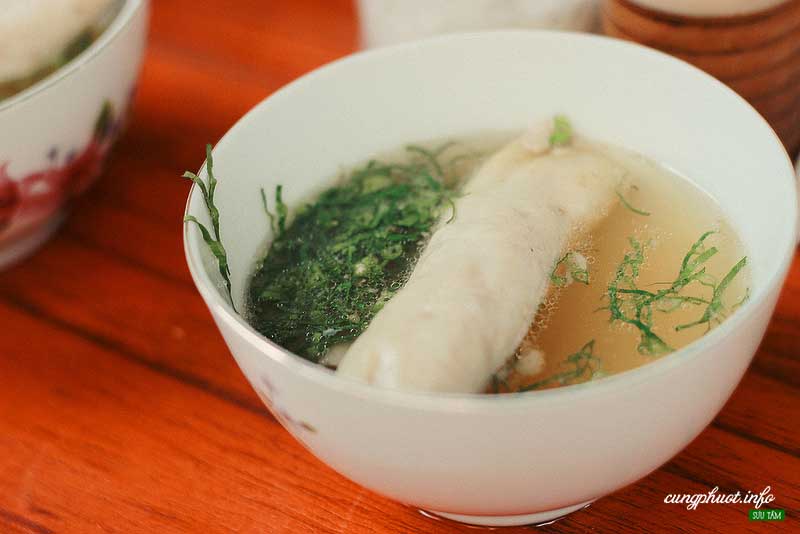
Cao Bang Roll Cake (Photo – Big Boy)
Roll cake is not a strange dish to the Northern people, but Cao Bang people have their own unique and unique way of “rewarding” the cake compared to all other regions.
In order to process fragrant rolls, one needs the tools of a big cast iron pot, a round shape to fit the mouth of the pot made of old bamboo, wrapped in a stretch of white cloth and a thin bamboo to take the cake out of the mold.
Delicious rolls depends on the quality of the rice. Baking rice is non-glutinous rice grown in Cao Bang, white, evenly-grained, fragrant and chewy. Rice is too soft or too dry, it is difficult to create a smooth, fragrant white cake dough.
The process of selecting rice and soaking the rice is prepared by the baker, but usually to keep up with the morning market, the owners often wake up to start the processing from 4-5 am.
The rice is soaked, washed and then wet; Previously, it had to grind with a stone mill, mill by hand, but nowadays most of it is mill by machine. The powdered water must be match, flexible, not too thick and not too thin to ensure that the cake is both chewy and soft. The rolls are not pre-coated, wait until customers call, the new owner quickly coated the dough, rolled the cake, but the ingredients such as chicken eggs, minced meat can be fried first to add to the cake.
Cao Bang rolls are the most special in the broth. Unlike Hanoians, Ha Nam people dipping cakes into sweet and sour sauce, Cao Bang people dipped cakes in sweet bone-simmered broth. Because of that, many people also call Cao Bang rice rolls as banh canh, to distinguish it from the fish sauce rolls of the lowland people. The broth is simmered from the bones of the pig the night before, so when it is poured into the bowl, it is clear that the bone marrow is fragrant and sweet. Each bowl of broth is added to a few tablespoons of minced meat, sprinkled with a bit of green onion, but also cool.
The most delicious and attractive is the egg roll cake, when the cake is on the mold, the giver breaks the chicken egg in the middle of the cake mold and covers it again, the cooked cake is wrapped with the egg yolk, square on the mold, using a spoon into the bowl for the guests. When eating, diners feel the sweetness of the bone stew mingled with the flavor of onion, the aroma of the scallion meat, the chewy taste of the cake in the broth. Many visitors from far away to eat rice rolls with soup feel strange for the first time, but when enjoying it, everyone compliments the delicious taste because of its richness and sophistication that is far from other places.
Dumplings
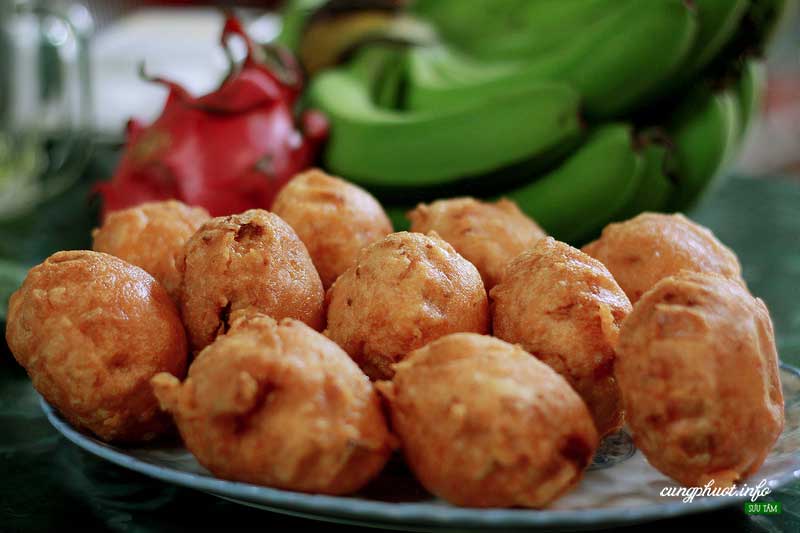
Banh Banh Chao in Cao Bang (Photo – Ngo Dinh)
Winter in Cao Bang has a very special dish, sold in many small shops or sidewalks. The appearance of the cake is quite similar to a donut, but the filling is made from duck meat, not minced pork, wood ear or green beans like normal donuts. Cao Bang people call it banh bao chao, or also called duck cake chao.
What ingredients to make banh giao are not too fussy, only include glutinous rice flour, glutinous rice flour and duck meat, but it is a unique culinary feature of the Northeast.
The crust is a mixture of sticky rice, non-glutinous rice, and soybeans. The selected type of rice is the newly harvested rice, the grains are mixed together, soaked carefully for about half a day to soften the rice before grinding into flour. People also choose Quang Uyen soybean with moderate seeds, yellow heart mixed with rice flour to create a thick flour mixture, ensuring flexibility and deliciousness.
After having enough ingredients, the maker takes a sufficient amount of flour, stuffs the duck filling in the middle, presses the cake and then slowly drops it into a pan of boiling oil, stirring until the cake is golden, two sides, radiating flavor. Fragrant seductive, picked out to drain the fat can be served hot.
Ants egg cake (Pan Ray)
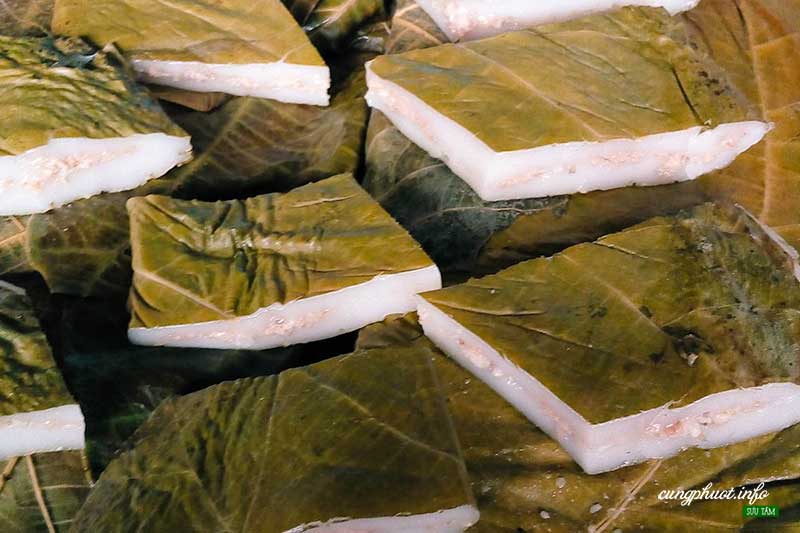
Ants egg cake in Cao Bang (Photo – Kim Dung)
Ant egg cake is one of the unique cakes of the Tay people in the northeastern mountainous region of our country, in the north of Kan and Cao Bang. The main ingredient to make this cake is ant eggs. This cake is usually only made at certain times at the end of April and May every year because this is the time of the strongest growth of the forest black ants.
As the name suggests, the main ingredients for making ants egg cakes are the young eggs of the ants for the cake, the glutinous rice flour and the young leaves of the fig tree wrapped outside (a familiar tree in the northern high mountains). The ingredients and the process are not too fussy, but if you want the cake to be delicious, the baker also needs to be skillful.
To get young ant eggs, people have to go to the forest to find nests of healthy ants such as small black ants, pointed tails, often nesting on trees such as vines, neohouzeaua or mittens. Ant eggs are usually the size of a grain of rice, milky white, plump and round.
After washing, ant eggs will be put on a frying pan with dried onions. Want to have a better taste, people also add a little minced pork, chopped roasted peanuts and a little sliced palanquin leaves. The roots of the palanquin are also finely sliced, pan fragrant, and then add ant eggs to the island until they are cooked, then put them down.
The cake is made from upland sticky rice with large and sticky seeds, served clean and soaked in cold water overnight, then drained, ground into flour and kneaded with water. After kneading the dough really soft and smooth, the glutinous dough will be rolled into a half-inch thin, to the size of a hand-sized square, then put the piece of glutinous dough into a fig leaf, sprinkle the filling on the cake dough, finally. is to put the next piece of fig leaf on the surface of that cake, wrapping the leaf so that the cake and filling are completely wrapped without being exposed to the outside. The cake is steamed for about 45 to 50 minutes in a water bath and cooked.
Sour pho
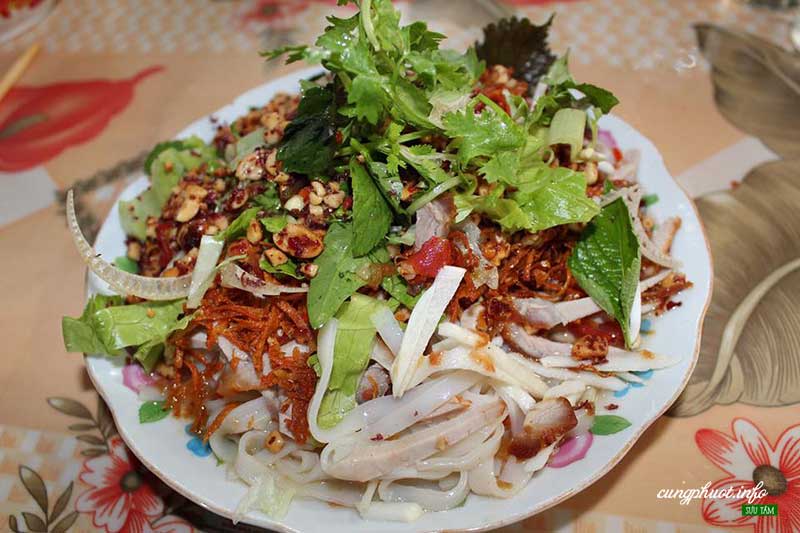
Pho Cao Bang (Photo – ThaoPhuong Phung)
Pho chua is a specialty of the Cao Bang region, contributing to enriching the culinary culture of the northern mountainous provinces. Sour noodle soup with many spices, ingredients such as crispy golden crispy bacon, Chinese potatoes (big, thin and sweet, only in Bac Can and Cao Bang) is cut deep fried, thinly sliced pork liver The pig’s stomach is cleaned and then boiled before being fried, the duck meat is round, fat is marinated with spices and especially the flavor of bile leaves is indispensable. Cao Bang noodle cake is fragrant, chewy, difficult to mix with other localities because it is made from sweet but flexible Cao Bang rice. In addition to the above ingredients, sour pho is also served with peanuts, herbs, basil, fragrant, thin sliced cucumbers.
The secret to creating an appeal for sour pho lies in the sauce. Non-aromatic garlic and onion then take the water from the roast duck’s belly to mix a little vinegar, garlic, sugar, fish sauce, then add some semolina to make her compare the pot. When enjoying, mix the bowl of pho quickly, but avoid crushing the noodle cake. Depending on each person’s taste, you can add spices such as chili and pepper. Sour noodle soup has a greasy taste of duck fat, the sour taste of vinegar, the pulp of peanuts, Chinese potatoes and liver mixed with the fatty taste of bacon, roasted meat, the aroma of the honey hook, the chewy texture of the noodle cake and spicy Concentration of chili. All the flavors blend together to awaken the user’s senses. Pho chua is a cold dish, so it is very popular in cool weather.
Pho chua is often used in weddings, commemoration ceremonies for diners to eat. But now Pho chua has appeared in many eateries or in food stalls in markets of Cao Bang province. Enjoying it for the first time, users cannot feel all the deliciousness and rich flavor of the dish, but when you get used to it, the delicious taste of spices, sweet and sour sauce and toughness of the cake. Pho will make you unforgettable forever.
Roasted duck with 7 flavors
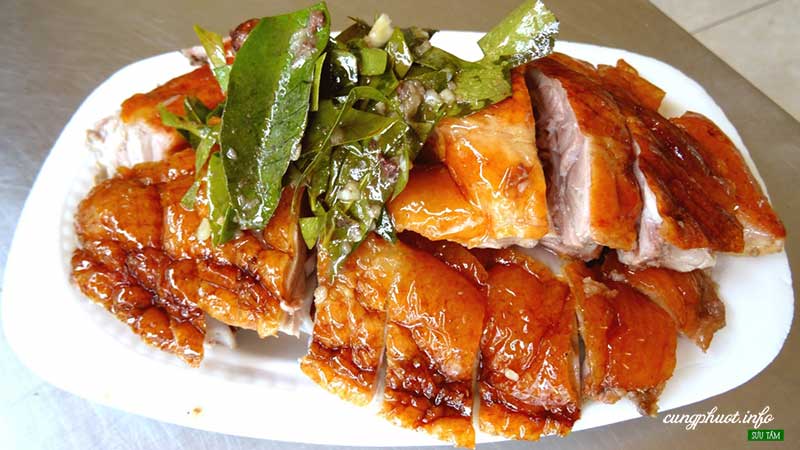
Roasted duck with 7 flavors of Cao Bang (Photo – thieunien.vn)
Roasted duck with 7 flavors is a specialty in Cao Bang. It is called 7 flavor roast duck because Cao Bang people have used 7 different spices to marinate duck meat.
After roasting, the duck meat is chopped into a plate, the skin is yellow in color of honey, the leaves of the cockroach are eaten. The meat is firm and sweet, soft but not friable, nor chewy. Every time you eat, one has to chew very slowly to feel all the sweetness of honey with the fatty taste of oil, the delicious taste of the young duck at the beginning of the month.
Inside each roast duck is a taste like the smell of young leaves, the taste is slightly bitter, but the sweeter you eat the meat. That’s because 7 spices are taken from the duck belly. Many people who have tasted them guessed that among these spices, there were many flavors such as the roots and leaves of the trees brought from the forest. Therefore, many people want to learn how to make Cao Bang roast duck, but they cannot have that characteristic taste.
Roasted suckling pig
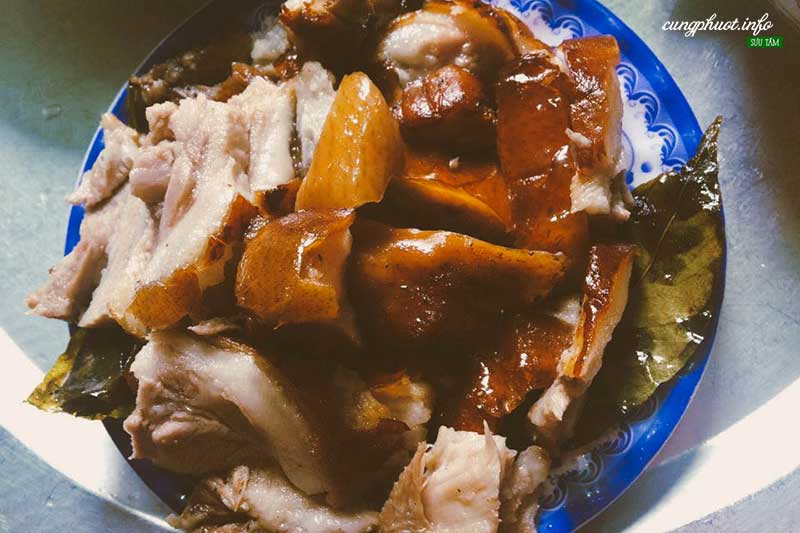
In addition to the duck, the roasted suckling pig in Cao Bang is also very delicious. (Photo – Hue Vu)
In Cao Bang, it is common to choose local pigs from 4 to 6 kg for roasting. After pre-processing is finished, use a tissue paper to dry the pig’s body (if washed with water, the flesh will be soft, not hunted, and all tastes are lost). Then stuffing honey-leaf and other spices into the pig’s belly, stitching it up, using a bamboo stick from the muzzle to the tail and then roasting on the charcoal stove, while rotating while using honey and other spices to spread over the pig allow to brittle and prevent from cracking. Delicious roast meat is just cooked meat, golden skin, crunchy, seductive aroma. Roasted pork dipping broth is prepared according to a very unique recipe.
Kitchen guard
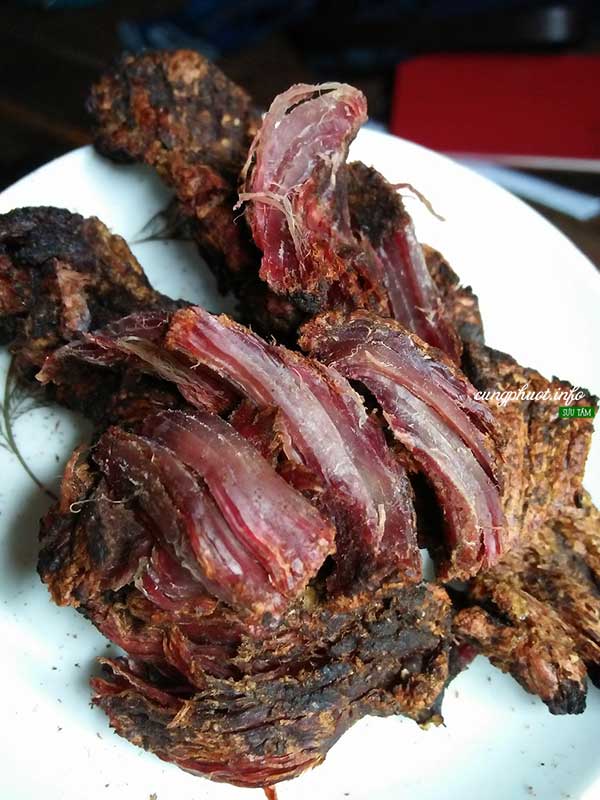
Kitchen guard beef is a popular dish of upland people (Photo – Truong hien)
Cao Bang is the place to raise a lot of cows, especially in the districts of Ha Quang, Bao Lac and Bao Lam. Having the opportunity to go to the remote highlands, enjoy the specialties of this place, do not miss the kitchen guard beef. Cows in Cao Bang to plow, pull carts. Beef to meat is also abundant. In particular, drying is a way of processing to preserve and store the beef of the local people, both for a long time and with a unique taste.
All kinds of beef used to dry are delicious, not picky. But the best taste is still the rump meat, corn meat, which is both lean and soft. The meat is cut into arbitrarily large pieces. But usually about two or three fingers, as long as the glove is the best. The meat is marinated with salt, ginger juice and especially white wine is indispensable. Before marinating, knead a few sugar on the meat for evenly infused spices. After marinating, use fresh bamboo strips to thread the meat into strings and hang it upstairs in the kitchen.
Sticky rice with Cao Bang
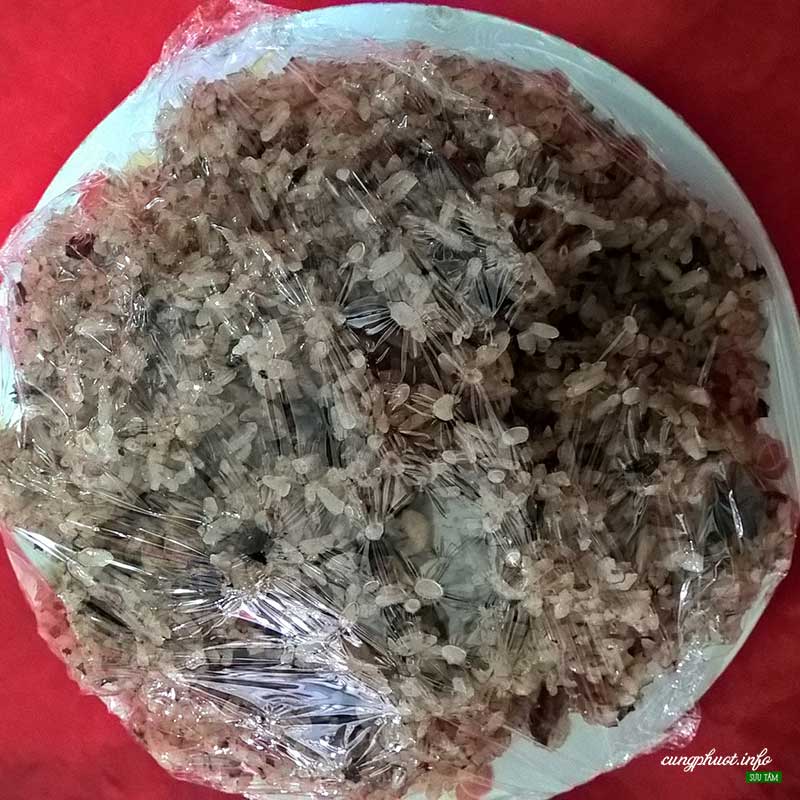
Sticky rice with Cao Bang (Photo – Hoang Uyen)
Going to Cao Bang, we will find sticky rice dish everywhere, from luxury restaurants, weddings to cozy family weekend meals. Unlike other types of sticky rice, Tram Tram has a gentle aroma of upland sticky rice mixed with the sweet aroma of canarium fillet. The pulp of the fillings covers the sticky and juicy seeds, doesn’t eat it all the time, and especially doesn’t feel hot in the neck, even though you eat a lot.
Marx fruit
Marxet is the name according to Tay, Nung, literally it is sweet fruit. Trees mainly grow at the foot of limestone mountains, a few of them on the slopes of rocky mountains and hill gardens are planted with seeds and seedlings; distributed in most districts in the province, but most concentrated in districts: Thach An, Ha Lang, Quang Uyen, Hoa An, Thong Nong.
Marx is an indispensable spice of many typical mountainous dishes, such as: Roasted duck, roasted pig … During the season of molasses, every housewife buys honey mark for processing dishes: fish stock. , braised meat, roasted duck, sautéed ham, broiler soup, sautéed bamboo shoots with honey mark … The elegant flavor of the honey-grade fruit has eliminated the fishy smell of fish, the smell of duck, and reduced the fat of the feet …, creating fragrant, delicate and attractive dishes.
Just to eat and cook dishes, marias are also available to eat all year round. Fruit with honey marks brought home using scissors to cut close to the stalk, then washed to drain. Thinly sliced fresh bamboo shoots, thread and a few fresh chili, a few slices of garlic, put in a jar soaked with salt water (can soak with white wine) for year round consumption. Pickled molasses is full of sour, spicy, salty and sweet flavors; Retaining sweet and sour taste and characteristic aroma, adding the crispy sour taste of bamboo shoots, the spicy taste of chili is very special. This dish is used for appetizers, dipping sauces, flavored dishes or stir-fries … are very delicious. In addition, during the full fruit season, they are brought to dry or dried, then used gradually or put in an ice tray for use all year round while the fruit still retains its delicious taste.
Gam river fried fish
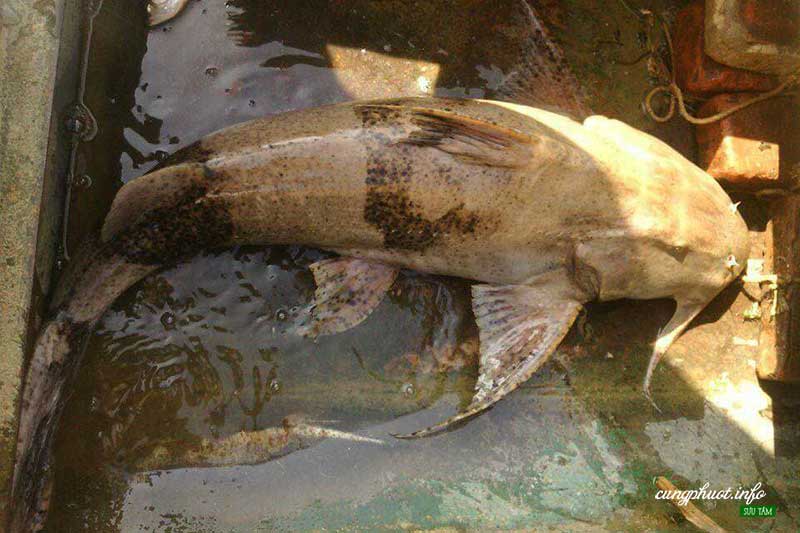
Fried fish, the “aquatic monster” species on Gam river (Photo – Linh Pham)
Cao Bang also has a famous specialty, which is the Gam river fried fish. This black fish ball is considered by the owner of La Vong fish ball shop to be the best for making fish ball. The heart of the fish is considered by gourmets to be the most delicious thing in the world.
Fried fish with up to several tens of kilograms of fish is difficult to catch because it specializes in living in underground caves in the river. The fishermen often close the camp often to wait for the fish, until they can catch any fish, someone comes to the place to buy.
Agarwood (Ban Gioc)
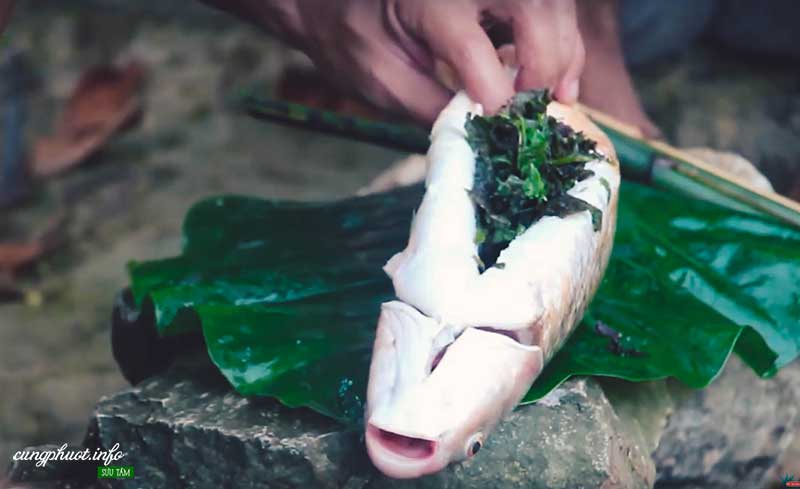
Grilled frankincense fish (Photo – Youtube VTV)
This is a famous fish species in Ban Gioc waterfall, Trung Khanh district (Cao Bang). Called frankincense fish because this fish often eats the roots and rotting leaves of the agarwood tree that grows along the Quay Son and Bac Vong rivers. Therefore, their meat is more delicious than many other types of fish, when eaten, you can feel the deep taste.
The best dish from frankincense fish is grilled, because it retains the taste of the fish, making gourmets admire. Fish are caught from the river, cleaned, cut open and then stuffed with some vegetables and spices such as onions, dill, chili … inside, wrapped with banana leaves and then put on a charcoal grill.
When cooked, the fish radiates a sobbing fragrance. Remove the fish dipping fish with a little pure fish sauce, feel the aroma of ecstasy, a subtle hint of taste that makes you remember forever.
Donated vegetables
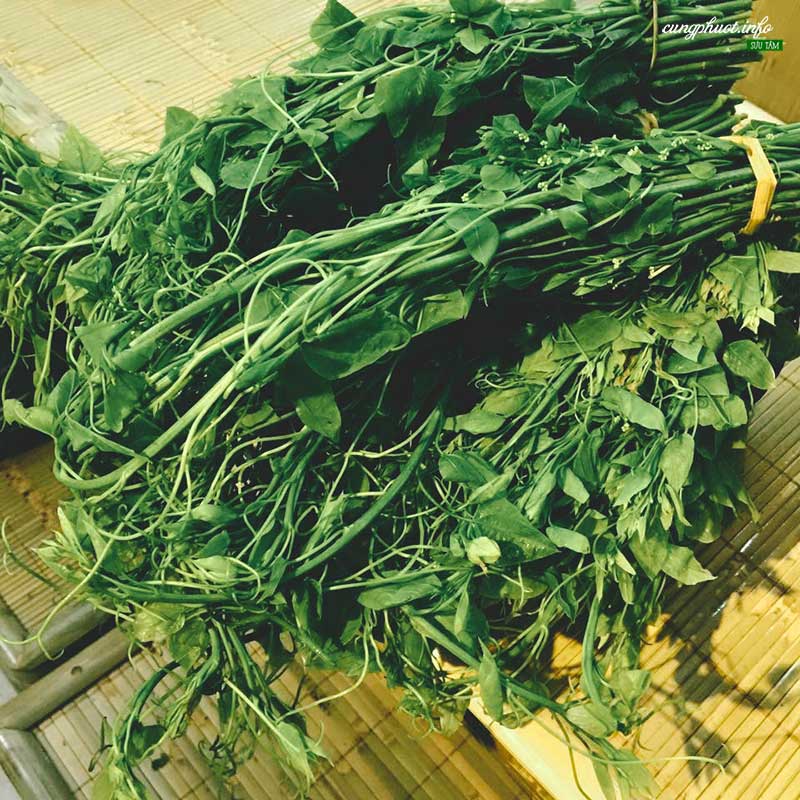
Da Hien Vegetable, also known as Bo Khai Vegetable (Photo – Le Duong Thuy)
Hyacinth, also known as Bo Khai, Tay – Nung called Phjac Dien, often grows wild in the rocky mountains. This type of tree is very brittle and brittle. The stem is divided into many large branches the size of chopsticks attached to the wooden trees to receive sunlight. Although it is a wild vegetable that grows wild, it is very rare in places. Therefore, from February to July of lunar calendar, if anyone comes into the forest to pick a handful of greens, it feels very precious.
Dedicated to Cao Bang is a specialty vegetable. During spring and summer, in the towns as well as in other places, there is almost no party where there is no dish of fried greens fried with beef, pork, and chicken heart. Indeed this is a very delicious dish that seems to be only available in Cao Bang. This wild vegetable has a very strange taste, unlike any other vegetable because of its particularly attractive and unforgettable taste.
Cao Bang specialties as gifts
Phia Den dong vermicelli
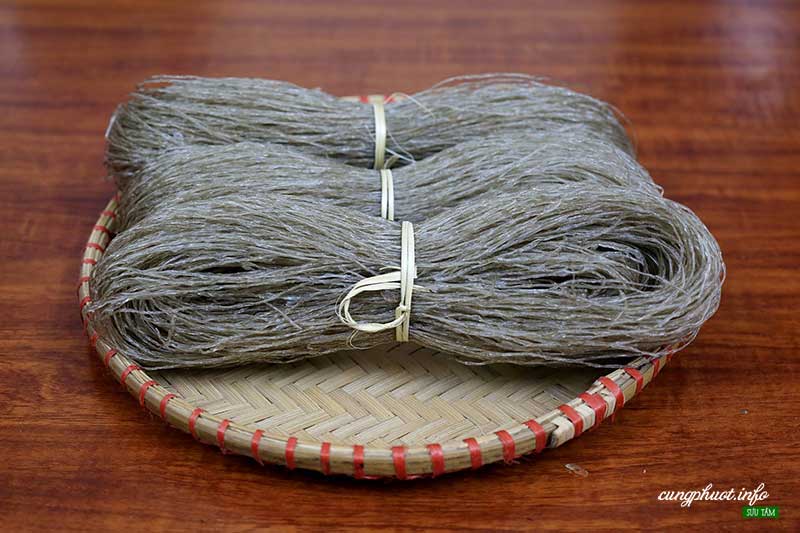
Phia Den dong vermicelli in recent years is a Cao Bang specialty that is hunted every Tet (Photo – Green Grocery)
Phia Den vermicelli is also known as Cao Bang dong vermicelli or Nguyen Binh dong vermicelli, because vermicelli is made in Den Den hamlet, Thanh Cong commune, Nguyen Binh district, Cao Bang province. Large, not glossy vermicelli like normal vermicelli. But it fascinates diners by the sweet fragrance of pure dong vermicelli.
Phia Den hamlet, Thanh Cong commune, Nguyen Binh district, Cao Bang province is a land blessed with a cool, temperate climate all year round, fertile soil suitable for the good growth of crops such as maize. , cassava and especially red galangal root. So the red galangal root here is always big and has the most characteristic aroma.
Phia Den dong vermicelli is made 100% from red galangal root grown on the mountain slopes of Nguyen Binh district in a traditional way, exposed to the glass, without using detergents, colorants, baking powder or other chemicals. When cooking the noodles are soft, clear, fragrant, chewy, sweet and cool, even after cooking the second time, the noodles are still tough, not sticky or crushed like other types of vermicelli.
Chongqing chestnuts
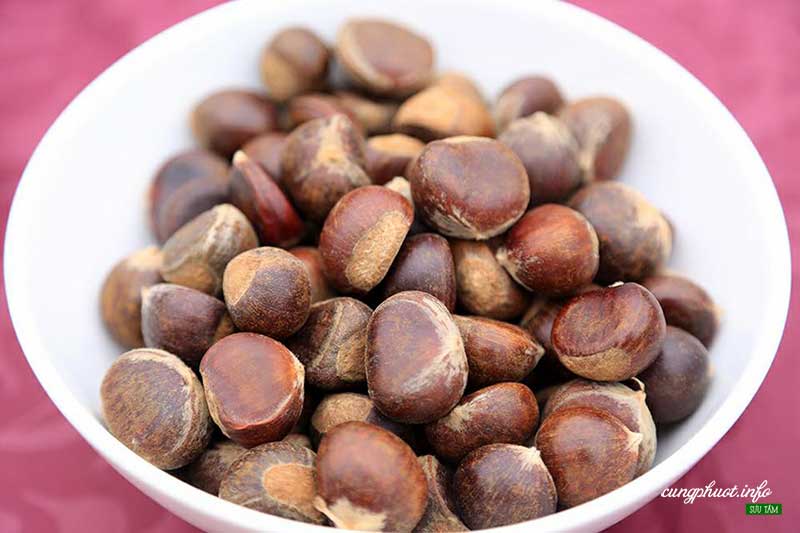
If you go to Ban Gioc Waterfall and want to buy Chongqing chestnuts as gifts, you must be careful not to buy the wrong Chinese chestnuts (Photo – Trai Nghiem Tien Dat)
Thanks to the cool air conditions and good weather, the chestnut tree in Chongqing is abundant and delicious. Chongqing chestnuts are usually as small as a big toe, very thin silk, dark yellow seeds, especially nutty and fragrant. In order to process the dishes often chestnut shells are very hard, so it is necessary to boil them thoroughly if they are ripe. Some people also carefully cut a few lines on the seed coat so that it is easy to peel when ripe. After boiling, if you bring the chestnuts to roast again until they smell natural. From there, the processor can simmer chestnuts with legs like a stew, can grind chestnuts to make a cake, can steam chestnuts to eat like people steamed jackfruit seeds …
Smoked sausage
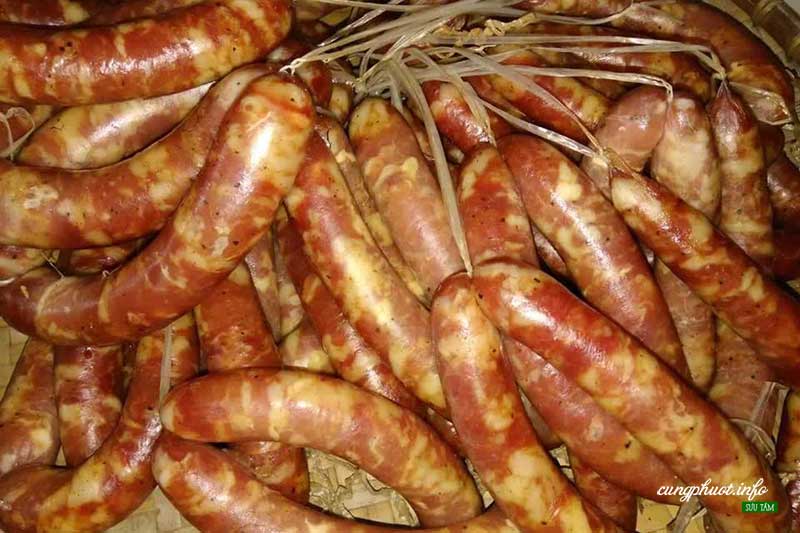
Cao Bang smoked sausage (Photo – Thu Lanh Nguy)
Regional ribs will be processed and seasoned with different spices. Ribs in Cao Bang are larger and processed more sophisticatedly than in the lowlands. The young heart is washed thoroughly with white wine. Sausage fillings are tenderloin, lean shoulder or lean buttock, the delicious parts of the black pork belly. Meat is minced, marinated with spices, minced and fragrant onions, especially the seeds are indispensable and a little wine creates a different aroma. Stuffed the sausage tightly into the intestine, so that the sausage is round and smooth. Kernels are stuffed, dried in the sun for about 3 days and then hung upstairs or smoked with bagasse. The warmth of the fire will make sausages tighten, toned, and even more fragrant with the sweet scent of bagasse. The ribs are sunny, with a bit of fire, the reddish pink color of the lean meat mixed with the ivory-white veins of the fatty meat looks very attractive.
Plum Bao Lac
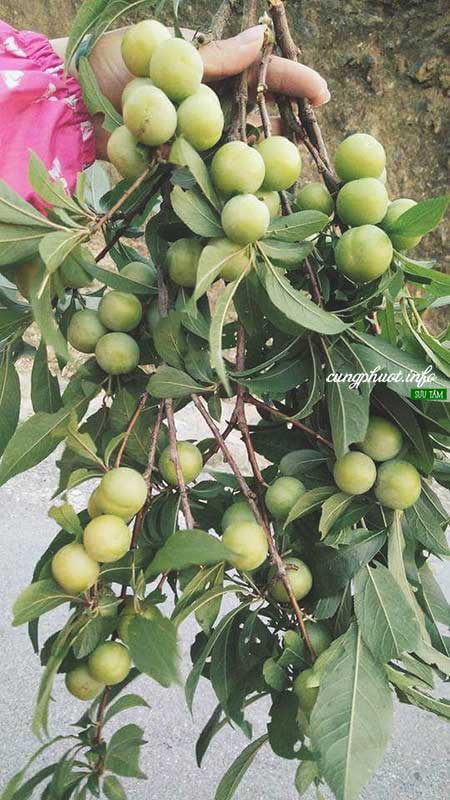
The plum Bao Lac is crunchy and delicious (Photo – Minh Hanh)
Plums are grown in all regions in Cao Bang, but Bao Lac is where the best plums are grown. Plum Bao Lac when ripe is red (called blood plums by locals), has a smooth, shiny skin, is as big as the tip of the big toe, and tastes sweet when eaten. Non-acidity is the distinctive feature of this type of bile.
Le Dong Khe
Pears in Dong Khe can be up to 0.5 kg per fruit (Photo – Bao Cao Bang)
Dong Khe is a place associated with a resounding victory of our army and people during the resistance war against the French in 1950 (Dong Khe border campaign, Cao Bang – 1950). This land has extremely suitable weather conditions for a kind of sweet and delicious fruit crop to become a famous fruit specialty of Cao Bang province. It is a pear. For a long time, Le Dong Khe is famous for its sweet and fragrant flavor, which is known as the famous Cao Bang specialty everywhere. Le Dong Khe is considered as a precious product of the mountains and forests, which is the pride of the people of Cao Bang.
Khao cake

The process of making Cao Bang cake (Photo – Truong Ta)
The rice cake is probably a dry food of the Tay and Nung people in Cao Bang. The cake is usually made on the occasion of Tet. It can be left out for a long time, so it is still Tet.
Making the cake test requires very skillful. When making the cake, anyone with tools can “do it”, but if you want to “eat well”, it is a masterpiece. The skillful baker is also the artisan.
Some things to note when traveling to Cao Bang
There are a few customs of ethnic minorities in Cao Bang that you need to know to avoid taboos, especially when visiting villages or staying at homestay services.
- When entering the house, if you find that at the door of the house, at the top of the stairs has a green tree branch, it is a sign that you don’t want strangers to enter the house.
- In the house, the altar is usually placed in the nave overlooking the main door. Guests when coming to play should avoid coming near, do not place personal items, do not touch their hands on worshiping objects. Women are not allowed to sit with their back to the altar.
- Nung people often put incense sticks on the floor to worship ghosts under the floor, strangers do not come near the incense tube
- The Tày people have the custom of worshiping Phi Phùng Phjày (fire spirit), visitors need to avoid loud or quarreling by the fire. / Follow Cungphuot

